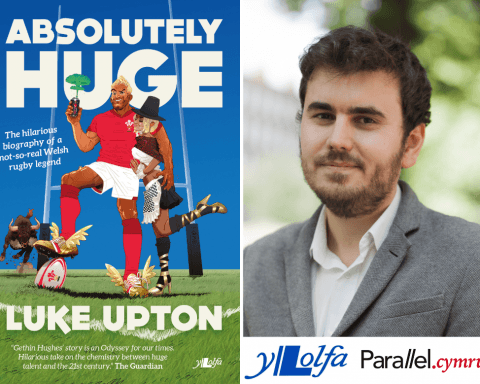Parallel.cymru is very fortunate to have an experienced traveller and great Welsh sports fan, Dai Rowlands, provide a travelogue of his journey to Japan for the Rugby World Cup- a perfect way to help those of us stuck behind our TVs and desks in Wales to get a feel for the experience of being there!
The following is a daily diary of a journey to Japan, the land of the rising sun, to watch the Welsh Rugby team play Fiji and Uruguay in the 2019 Rugby World Cup. Neil Rowlands invited me to compile this diary for inclusion in the increasingly popular Parallel.cymru website.
Following Neil’s invitation, I thought back to the stimulus to undertake such a journey. Recollections of Euro 2016 came flooding back when the Welsh football qualified for a major tournament for the first time in almost 60 years. I was fortunate enough to attend every Welsh match in that pulsating tournament. Memories of the camaraderie, national passion and pure excitement were the major factors in wanting to support the national team once again in a major tournament, even if the shape of the ball was different this time around.
Sister Linda and myself travelled to Bordeaux for the first match of Euro 2016 against Slovakia. We will never forget that first morning of the tournament for the Welsh fans. We sat at a typical French café opposite Bordeaux central station in glorious sunshine. There were endless streams of Welsh fans exiting the station as trains rolled in from Paris and other destinations across France. This was just the beginning, and as we made our way into the centre of Bordeaux, we began to realise how many fans had travelled to support the national team. Various football songs and Welsh hymns were sung loudly from the endless French bars and restaurants. This set the scene for a fabulous five weeks travelling across the breadth of France to Lens, Lille, Toulouse, Paris etc. It is the memories of these fantastic times that gave the impetus needed to make the commitment to travel much further afield and join the thousands of Welsh rugby supporters in Japan for RWC2019, provided of course tickets, flights and an itinerary could be sourced and within budget.

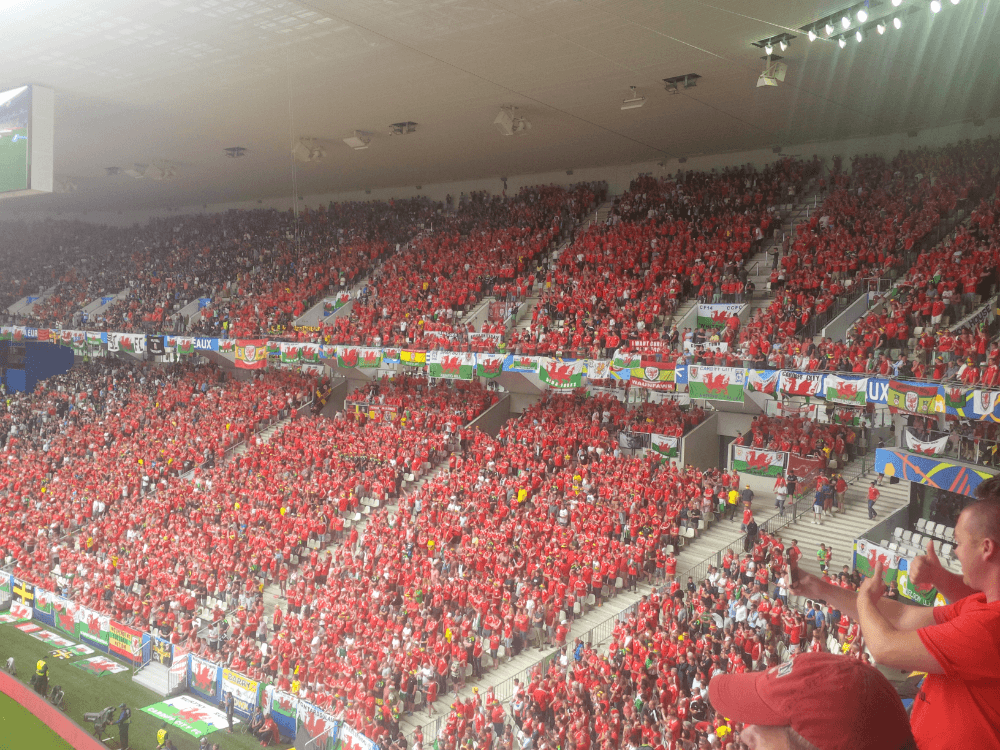
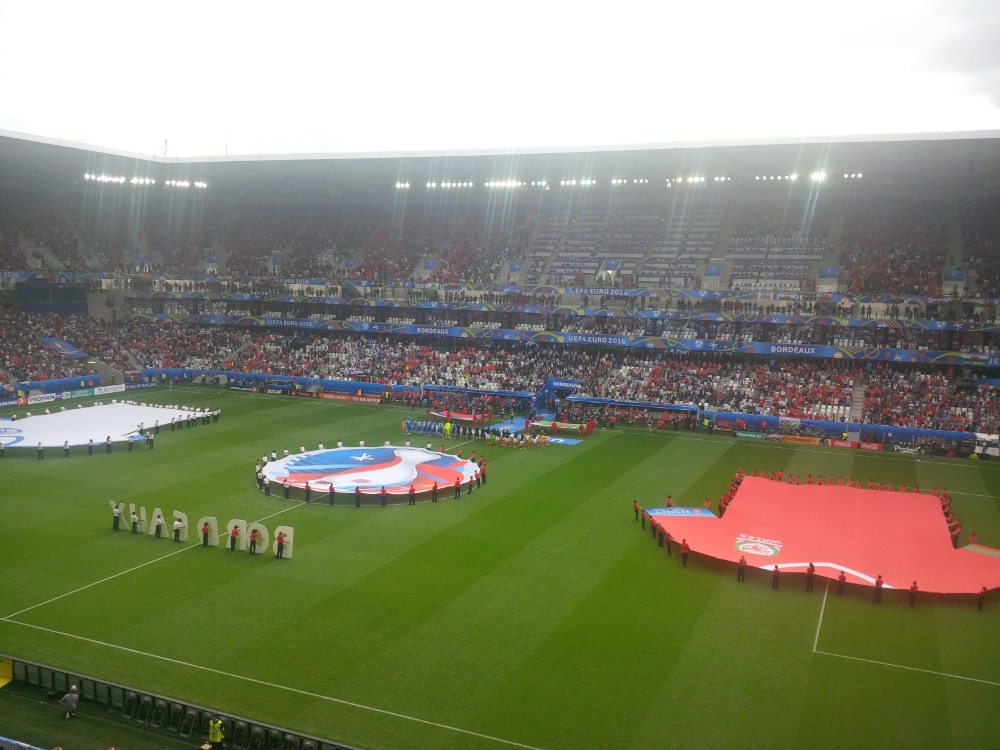
A café in Bordeaux
The Red Wall of fans in Bordeaux
The Anthems- Wales vs Slovakia
The first task was to source match-day tickets which were on sale via the official RWC2019 website. Two of the Welsh matches (Georgia and Australia) were set for September with the Fiji and Uruguay matches being scheduled in October. Various constraints meant it was only practical to attend two of the group matches which were those to be played in October (Fiji and Uruguay).
Purchasing tickets was not as straightforward as expected and required registering in a queue of 20 hours with the RWC2019 website. The lengthy queue was due to the sheer number of applications from supporters of the 20 teams participating in the tournament. When your turn eventually came about, a notification email from RWC2019 was received giving 30 minutes to log on and order your tickets otherwise the place in the queue is forfeited and the process starts over again. After a couple of false starts, tickets were eventually secured for Wales versus Fiji and Uruguay- both being played on the island of Kyushu in the south of Japan. Kyushu is a six hour bullet train journey from Tokyo.
With tickets secured, the next stage was to seek suitable flights which fitted with the matches being held on 9th and 13th October respectively. Qatar Airways from London to Tokyo via Doha satisfied the criteria with departure from London Heathrow on Saturday 5th October. The initial itinerary included a one hour transit in Doha although this was soon to be rescheduled by Qatar airlines such that the stopover in Doha grew to more than 5 hours…….. ho hum, the joy of international travel.
With the relatively easy components of the plan completed by May, it was time to embark on the daunting task of arranging an itinerary within Japan, a country with a different culture, time zone and language. Initial enquiries showed that all types of accommodation in Oita the location of the Fiji match, were already fully booked. Oita being apparently only a small town, mild panic ensued and it was time to consider alternative strategies. Google searches on tour operators within Japan threw up a couple of possibilities. Both companies requested various details including arrival/departure dates, the matches for which tickets had been obtained, preferred mode of transport within Japan etc. Inside Japan Tours (a subsidiary of Inside Asia Tours) were terrific, very helpful and with a number of suggestions and alternatives. Within a few days, they forwarded a proposed and detailed, day-by-day itinerary together with budget. This included metro tickets from Tokyo Haneda airport to the Ibis hotel downtown Tokyo, an 8 day bullet train pass, and all the required transfers including 2 hour coach return journey from a hotel in Fukuoka to the stadium in Oita shared with many other Welsh supporters who similarly could not secure accommodation in Oita.
Decision made and the booking was confirmed with Inside Japan Tours (strongly recommended for anyone visiting Japan). A detailed itinerary and various tour guides were gratefully received in addition to a goody pack of official baseball cap, rugby jersey, umbrella and luggage tag.
Wey hey, with all plans made it seems we are all ready for a memorable journey to support Wales at RWC2019.
Saturday 5th October: Hampshire to Doha
ng ShinjukuDawn in the Hampshire village of Crondall brought a grey and damp day. Much of the preparatory packing had been done earlier in the week so all that was required was a final check of clothing, toiletries, Welsh rugby shirts and flag.
First up in the morning was a visit to the local David Lloyd leisure centre for a workout in a virtual spin class with the aim being to get as physically tired as possible before the twenty five hour journey to Tokyo. After the spin, it was home to watch England thrash Argentina and secure qualification to the quarter finals of RWC2019. The lawn needed a final mow which provided more physical exertion then out with the darling wife, Kate for a farewell coffee in the nearby village of Odiham.
Kate was her usual superstar and provided transportation to Heathrow T4 for flight QR8 to Doha with departure at 16.00. Whilst in the airport lounge, brother John was providing score updates for the WBA versus Cardiff City football game which he was listening to via Cardiff City world. The mighty bluebirds ending their 7 match unbeaten run with a 4-2 defeat.
QR8 was on time departing Heathrow T4 arriving in Doha some six hours later. An uneventful flight arrived at half past midnight local time on October 6th.
Sunday 6th October: Doha to Tokyo
Qatar airport is much bigger than expected and has the usual array of large and expensive duty-free shops. The aim was to get some sleep and attempt to move forward a little onto Tokyo time. This didn’t happen so spent a frustrating 5 hours reading, surfing and snacking. The airport was busy on arrival and became quieter around 2am with footfall picking up again around 5ish. We were called to gate A7 at 06:00 for the scheduled 06.45 departure of flight QR 812 to Tokyo Haneda airport only to be frustrated by the late arrival of the incoming flight which caused a delay of more than 30 minutes to departure. This was a concern as arrival in Tokyo was scheduled for 22:40, whilst the last train to Shinjuku, the district of Tokyo where the Ibis hotel is located, departs at 23:55. Being aware of this tight connection to the last metro to Shinjuku, a swap of messages with Inside Japan a couple of weeks before setting off gave a couple of alternatives. These are a bus at 01:00 or last resort is a taxi. Despite the lateness of the flight, the target was still to catch the train as I was in possession of a metro ticket supplied by Inside Japan and didn’t really want the additional expense of bus or taxi.
QR812 is a 10 hour slog and not having slept for more than 20 hours, the first three hours of the flight was a welcome deep sleep.
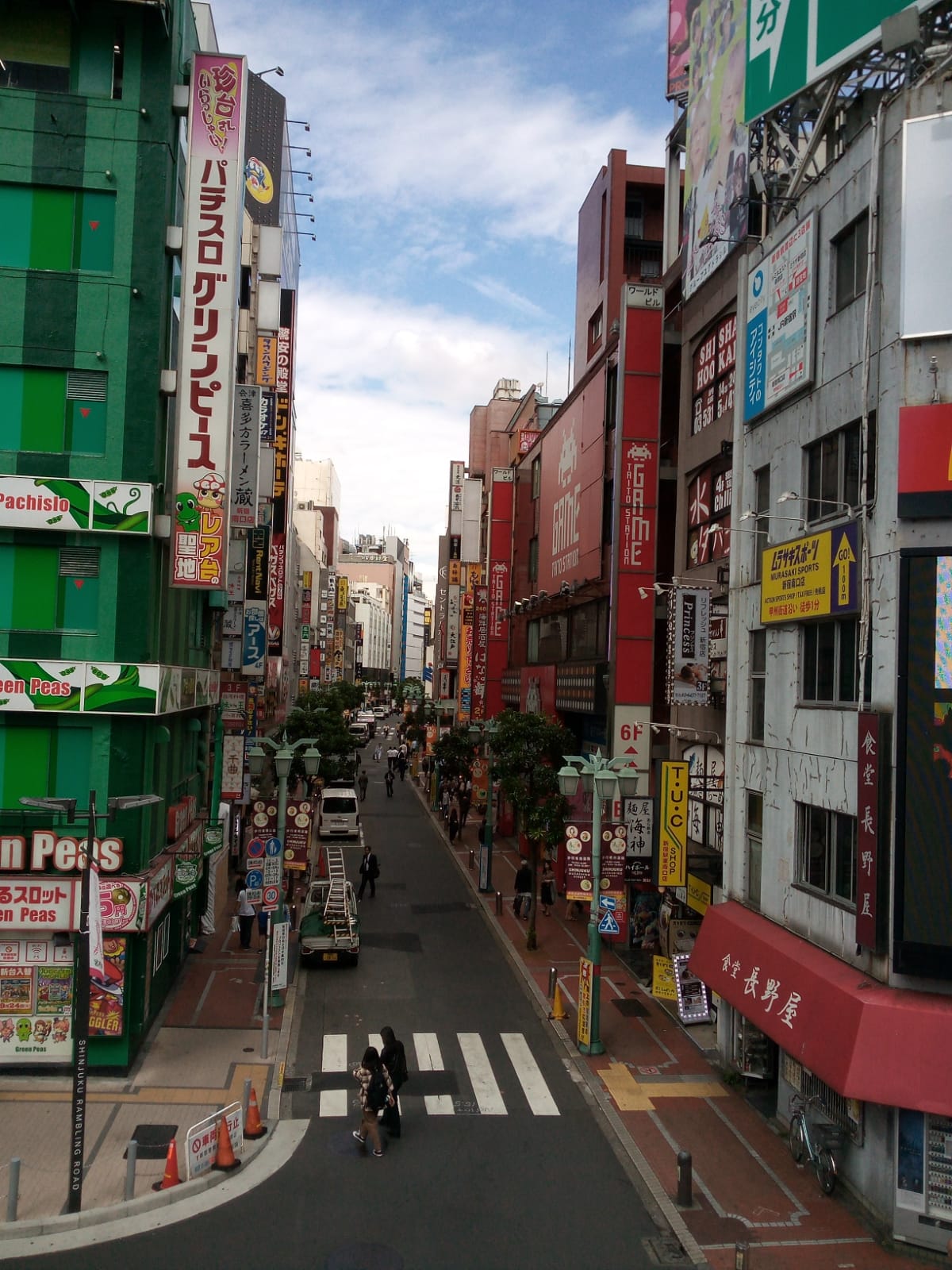
The inflight entertainment on Qatar airways is fantastic with a wide array of movies and music channels. Having never watched Chernobyl, the BBC docu-drama, this was selected as choice of viewing and managed to binge watch three episodes before the headphones started to become annoying and there is only so much TV that can be watched in one session.
Looking out the window at the endless miles of barren landscape below made me realise how very lucky we are to live on our lush green island. The inflight interactive map on the modern A350 showed we were flying north of the Himalayas through southern Russia and into China. There were no trees or greenery for more than 1,000 miles (2 hours flying at 500mph), only punctuations of occasional industrial settlements in what resembled a brown, craggy moonscape. Just at that moment, I really wanted to know more about the industrial development and mining industry in this remote region and the unimaginable life of the workforces in these industrial outposts.
Having departed Doha just after 0700am, the first seven hours of the flight were in daylight, however as we travelled eastwards over China, dusk and eventually nightfall ensued. Having travelled extensively in a 37 career in the oil and gas industry, one very useful trick learned to minimise jet lag is to set your watch to the time of your destination at the beginning of the journey. Consequently, you are preparing both mind and body throughout the journey. This being said, as we flew over the yellow river in China, it was 19:45 Tokyo time, 8 hours ahead of UK and the body clock was very confused. What happened to Sunday 6th October?
Monday 7th October: Arriving in Tokyo
Monday’s dialogue is subdivided onto two sections, punctuated with a welcome night sleep.
 QR812 arrived in Tokyo’s Haneda airport 20 minutes late and although there were queues at both the immigration and customs checks, Japanese efficiency came to the fore and consequently the train from Haneda airport to downtown Tokyo was caught with some time to spare. A change at Shingawa onto the JY line for the vibrant district of Shinjuku. I always thought that a map of London’s rail and underground network was confusing, but take a look at Tokyo’s mind-blowing railway and subway network – a big WOW!
QR812 arrived in Tokyo’s Haneda airport 20 minutes late and although there were queues at both the immigration and customs checks, Japanese efficiency came to the fore and consequently the train from Haneda airport to downtown Tokyo was caught with some time to spare. A change at Shingawa onto the JY line for the vibrant district of Shinjuku. I always thought that a map of London’s rail and underground network was confusing, but take a look at Tokyo’s mind-blowing railway and subway network – a big WOW!
During the journey from Haneda to Shinjuku, you become aware immediately by the difference in culture to back home. There are recycling receptacles everywhere, all used diligently. There is no litter, people don’t eat or drink in public and although almost all the younger folk seemed joined to some form of electronic media, most often a mobile telephone, nobody makes or takes calls in public. This became apparent throughout the trip, when locals would walk outside bars, restaurants and cafes to make and take calls. The Japanese are so very polite and considerate to other people.
The transport system from the airport is older than expected, but very clean and punctual. By now it was gone midnight but the JY train to Shinjuku was packed with late night Japanese revellers and one very tired Taff.
Shinjuku station is apparently the world’s busiest used by more than two million people each day. There are so many exists (east, south east, west, south etc etc) and the numerous concourses spread for more than half. I had no idea where to exit and eventually selected the south exit as it was the closest. The outside of the station was a vast array of skscrapers and neon lights. I had no idea where to turn to find the Ibis, Shinjuku hotel. I asked a couple of innocent revellers, one of whom very kindly walked with me the 15 minutes to the Ibis. He told me that he lived in that direction. Such is the politeness of the Japanese.
The bar at the Ibis had apparently long closed, but I had caught glimpse of a British bar, the Hub, the other side of the road and immediately opposite the entrance to the Ibis. As it was so late, I couldn’t be bothered to deposit the luggage in the designated hotel room, but instead went straight to the Hub for a much needed beer or three. The cozy bar, playing live Premier League football (it was early Sunday evening in UK) was still buzzing at 1am and it didn’t take long to strike up conversation with other rugby fans – mainly Brits. There was one other Welsh guy in the Hub, Gareth, and judging by the look in his eyes, had been in the bar for some time. Within thirty minutes of arriving, we were “entertaining” (the word is used loosely) the rest of the Hub drinkers with our interpretation of Sosban Fach and Men of Harlech. So impressed were the others present that they requested an encore. Sparkly-eyed Gareth wasn’t quite up to any more singing, so we called time on our entertainment session.
As a Welshman travelling alone, I was invited to join a couple of other groups of fans. We each swapped stories of our itineraries, where we came from and other meaningless alcohol-stimulated chit-chat. This brought back many memories of our attendance at Euro 2016, where we met numerous football and Welsh supporters from all over the country and exchanged stories into the early hours. For anybody that has not attended such a major sporting event, this aspect of the tournament is compelling. So many interesting people, everyone with a different story to tell and so willing to provide advice if needed. It really is akin to an enormous extended family, each with different roots but each with a common aim- to support their team. In many respects, the actual games are merely an interruption to a fantastic social occasion.
It was gone 2am, the bartenders, all wearing rugby shirts, had called last orders so it was time to walk back across the road to the Ibis and the tiny room that will be home for a couple of nights. Certainly no space for swinging pussycats, not even a kitten! Even though so late, you are immediately struck by the in-room technology with the most complicated tap system and loo flushing ever witnessed. Grasping the basics before sending goodnight wishes to my darling wife which evolved onto a very welcome deep sleep.
Later that morning and following a light breakfast at the Ibis, there were two tasks to be undertaken prior to some Tokyo sightseeing. First up was the purchase of an adaptor to facilitate charging of electrical appliances which was purchased at a fascinating Japanese store crammed full of all sorts of household goods and very little room to move. The required adaptor was found on the third floor amongst loads of similar electrical appliances.
Then it was off to the JR (Japanese Railways) ticket office at the vast Shinjuku station to exchange a pre-purchased voucher for a ten day railcard and also to reserve seats on a Tuesday morning bullet train to Fukuoka on the island of Kyushu. This sounds straightforward, but in such a vast station, with so many different ticket offices, it required a degree of patience.
Tokyo is a huge and busy city with a population over 13 million. It is divided into districts, each with its own identity. Shinjuku, according to the guidebooks is one of the busiest of these districts and host to an exciting and eclectic nightlife. It is overwhelming just walking around the streets. The noise and sheer number of people is claustrophobic and overwhelming to someone more used to the space and relative tranquillity of a Hampshire village. For anyone requiring their own personal space, Tokyo is not the city for them.
By late-morning, some form of escape and space was urgently required from the noise and enormity of the city and its hoardes of people.
Most of the cafes, restaurants and coffee shops were tiny and rammed with locals enjoying morning coffee or an early lunch. Eventually, a more spacious, not so busy, air conditioned, coffee shop provided much needed respite from the mad craziness of Shinjuku’s packed streets. A leisurely and comfortable hour was spent consulting various guidebooks from which a plan gradually emerged to try and wrestle back at least some sanity and normality. This certainly did NOT involve any form of transport system, having overdosed on travelling the previous two days. Shinjuku Gyoen National Gardens was only a short walk away and was recommended as a “must visit” in one of the guides. Armed with map in hand, I ventured back outside into the wild world of Shinjuku and navigated the packed streets in search of Gyoen Gardens.
Phew, what a relief. On reaching the gardens there was greenery, space, much fewer people and little traffic. Chill time……. pause and relax.
You never know what to expect when visiting different countries, cities and cultures. Mentally, I was certainly not prepared for the vastness and business of this amazing city. Gyoen gardens gave time and space to recover and reassess.
Hunger and tiredness ensued so I meandered through a not so crowded district, stopping firstly at one of the numerous Tulley’s coffee shops for an iced coffee and then at a small, typical Japanese restaurant down one of the many crowded alleyways where they served a fab rice dish- devoured with wooden chopsticks.
Later, enjoying a late afternoon tea in the relative tranquillity of the lounge at the Ibis hotel and catching up on news and emails, a group of six weary looking Welsh folk checked in to the hotel. Swapping stories in the time-honoured manner at these events, they had left Abertillery at 04:00 am the previous morning (Sunday) for a drive to Heathrow and then onto Tokyo with Etihad which included a two hour stopover in Abu Dhabi. They were already drinking the local beer served at the Ibis and were very pleased to hear about the Hub bar across the road. In fact, one of the guys insisted that I show him the exact location of the tiny entrance to the Hub which was easily missed in the surrounding vastness.
Whilst reading the guidebooks earlier in the day, a plan had been hatched for the evening which incorporated a twenty minute walk to a district supposedly less busy than Shinjuku but apparently with a good selection of bars and restaurants. Armed with an umbrella to protect against the increasingly heavy rainfall, it was back out into the madness and bright lights. Virtually every shop, café and restaurant had loud music blaring from their entrances to add to the general overpowering din. Dodging all the other umbrellas and with map getting increasingly damp, I walked briskly to the planned destination only to be disappointed by the small selection of options. Turn around and head back through the rain to the craziness and huge array of options in Shinjuku. It was difficult to decide where to eat, but the choice was whittled down dramatically as only 10% of the eateries had menus in both English as well as Japanese. Furthermore, many of the establishments were not on ground level but either below ground or on various floors of the many tall buildings. First up however, was a pre-dinner beer in a basement bar. The bar was packed with locals screaming at the live Tokyo league baseball being shown on the many TV screens around. I sat on the one spare seat in the bar and just watched in amazement as the excited baseball fans cheered at the action. The audience was split equally between the Bears and the Chiefs. I can only imagine the atmosphere when Japan are playing their games at RWC2019.
Back out into the rain and onto one of the many small local restaurants which included the menu with an English interpretation albeit in very small letters. The first mistake was to order a large beer. It took both hands to lift the litre glass and it took the duration of the kebab meal to consume.
The rain was still falling as chaos was once again confronted en-route to the Ibis via a briefish stop for a nightcap of the local cider – yummee scrumpy. Surprising that smoking is still allowed in many of the establishments and yet banished from the streets. There are notices on the pavements stating “no smoking” and consequently there are smoking areas partitioned off along the walkways for the many Japanese that smoke.
The final stop was the 7-11 store a short distance from the Ibis. Whilst looking for a suitable choccie bar for a midnight munch, I bumped into three Welsh guys, Owain, Glyn and Gareth. The latter was my duet partner from the previous night. They were purchasing a cheap bottle of local red wine to take back to their hotel room on the basis it was much cheaper than that served at the Hub. It transpired that Owain, Glyn and Gareth were from Glyneath and were flying south the following morning for the Wales versus Fiji match on Wednesday. No surprise there!
Owain was a similar age as myself, and on learning of my Maesteg roots, he asked if I knew a Margaret Jones from Glycorrwg on the basis it was close to Maesteg. Apparently, he met Margaret at a rugby international in Cardiff many years ago and had not forgotten her. How sweet and such a bizarre conversation for a small supermarket at midnight in downtown Tokyo but so typical of these events.
The white chocolate was divine and consumed whilst sending good night wishes to Mrs Rowlands.

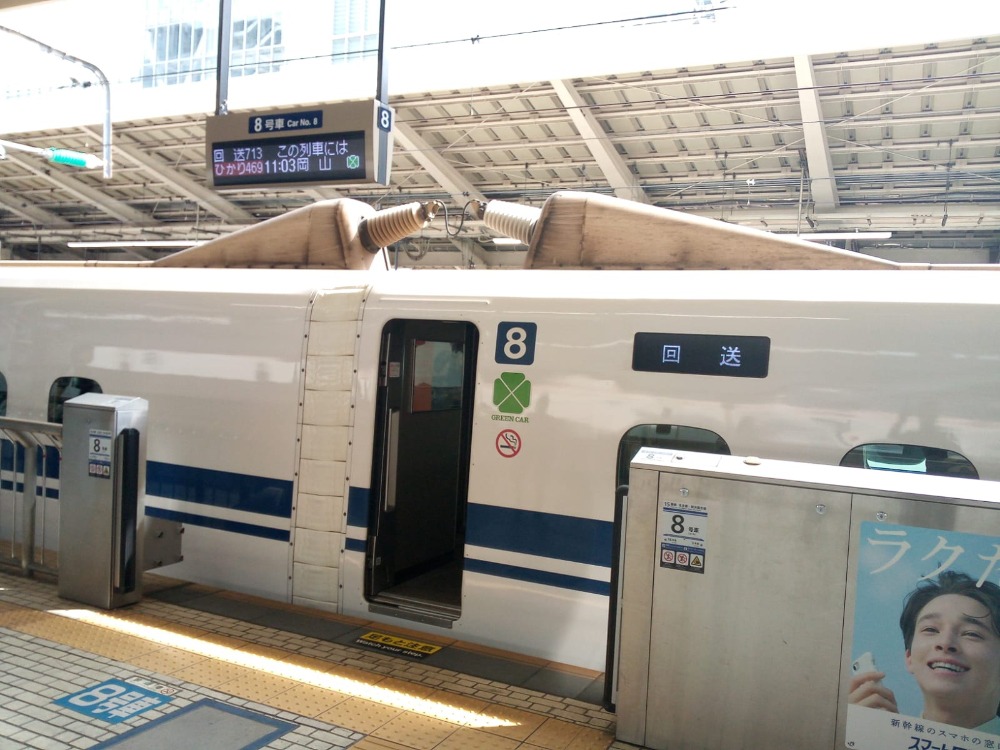
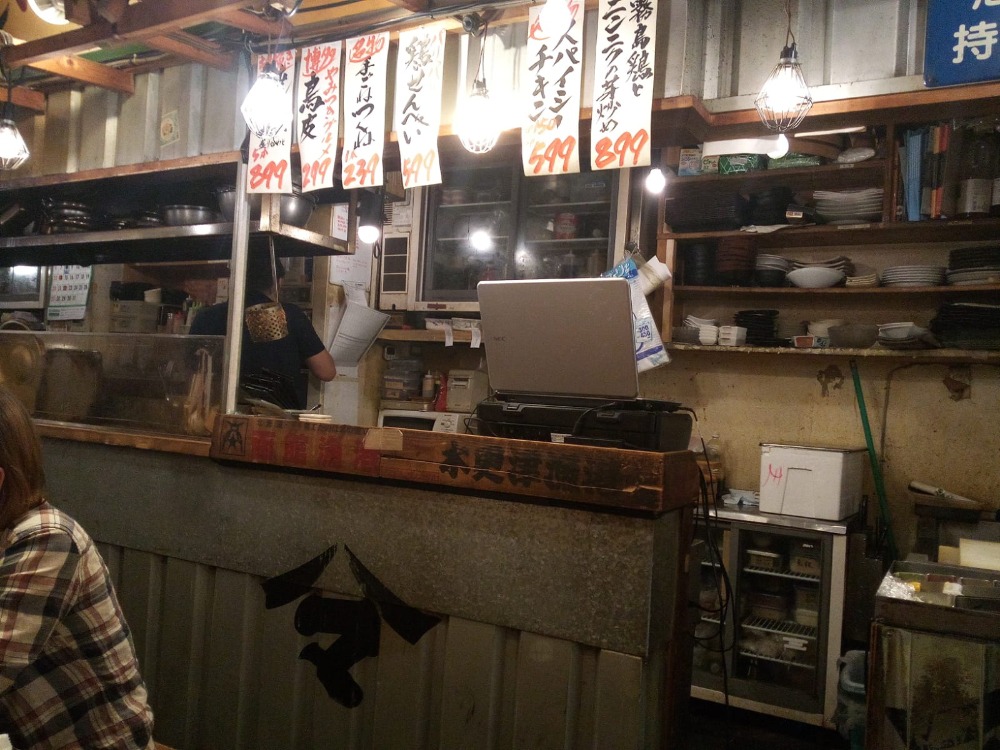
Tokyo station
A Bullet Train
Din-dins
Tuesday 8th October: The journey south to Kyushu Island
Today commences the journey south to Kyushu island in preparation for tomorrow’s match against Fiji. Get up at 07:00 and begin to pack. This isn’t difficult as the luggage was never really unpacked due to the lack of space in the hotel room that more likened a student’s hall of residence. Shower followed by a small nondescript breakfast then time to venture back out into the wild world of Shinjuku except at 08:30 it is rush hour in Tokyo. Wild has become super-manic especially as the temperature was over 20 degrees and both holdall and rucsac were also making the journey south. Shinjuku station was busier than previously witnessed and it was easy to imagine how 2 million people travel through this station every morning.
The rapid transits to Tokyo central station depart from platforms 7 and 8 every two minutes in rush hour. I caught a glimpse of a local commuter eyeing my luggage and the reason for this soon became obvious. There is yellow signage every ten metres on the platforms indicating where the carriage doors would open. There were orderly queues at each embarkation point. I joined one of these queues. But what happened next is still difficult to comprehend. A rapid transit train approached platform 7. When it arrived, commuter faces were squashed against windows in crowded carriages and yet, with the help of strong platform assistants, most of the waiting passengers were physically pushed into the carriage. This was not for me, so I stepped sideways out of the queue and gathered my thoughts as the next transit approached platform 8. A quick decision needed to be made and really there was no option but to join another queue, breathe deeply and wait for what happens next. This train did not seem as full as the previous train and there was initially room for a small Welshman and his luggage. Any spare space rapidly disappeared within seconds as the sturdy platform assistants shoehorned more and more passengers onto the already overfull carriage. Standing nose to armpit with one tall local and feeling like a sandwich filling between four others the train moved off. It was impossible to reach an overhanging handle in an attempt to stabilise my footing, but that didn’t matter as there was no room to fall as all the passengers swayed in unison in sympathy with the train’s motion. The air conditioning in the carriage was turned to maximum but it had little effect in cooling down the body heat generated by the patient commuters. Embarrassingly, I was the only person sweating- the others must be accustomed to the discomfort.
Unbeknown when boarding, there were three stops on this rapid transit to Tokyo central station. What a relief when after 8 minutes of hell, the train stopped at a Tokyo suburb and 80% of the passengers disembarked. There was space to sit under one of the AC vents which provided huge comfort for the remaining 12 minutes of the journey.
It was difficult to tell if Tokyo central station is as big as Shinjuku station for the simple reason that both stations are so vast, it is impossible to see their extremities. What is becoming obvious, is that railway stations form a focal point in Japanese cities and contain shopping centres, entertainment complexes as well as many cafes and eateries.
Time to take stock at Tokyo Central station in the middle of rush hour and seek out where the JR bullet train for Hakata, Fukuoko would depart. Luckily there are lots of station assistants in the many cavernous underground concourses. I eventually found platform 15 from where the 11:03 bullet train to Shin Kobe would depart. There was a nearby French coffee shop which provided much needed sanctuary for an hour or so.
As with all public transport in Japan, the bullet train was punctual to the minute even though boarding was not permitted until the multitude of cleaners had left the train. Similar to the UK, the Japanese rail network is run by different franchises for different regions. Each franchise has its own style of bullet train- all very futuristic, resembling horizontal space rockets. The first leg of the journey to Shin Kobe was aboard the Shinkansen franchise which differed from the second leg from Shin Kobe to Hakata.
We eased gently out of Tokyo central station before the afterburners kicked in. The acceleration was unbelievable and yet it still took more than twenty minutes until we reached the outskirts of Tokyo and the first of only a few stops at Yokohama.
Behind was a city of bewilderment. The logistics are unimaginable. So many questions unanswered. It is difficult to comprehend how a city of the size of Tokyo came about, and furthermore how it functions- and functions so efficiently. However, for now, I was pleased to leave Tokyo behind and travel southward in support of the Welsh national rugby team.
Footnote – there is one type of shop that you simply do not see in Tokyo – garden centres. When travelling overground through the endless suburbs of Tokyo, not one of the cramped, characterless houses and apartment blocks had a garden of any description- in fact there was virtually no greenery to be seen anywhere. Don’t ever consider opening a garden centre in Tokyo. Doomed to fail!
As the train rapidly journeyed southward, the scenery eventually changed. The urban landscape of the previous two days had been replaced by a rural landscape punctuated by industrial towns incorporating manufacturing, the likes of which we can only dream about in UK. Rice fields dominated the rural landscape and eventually lush, deep green forests covered the mountains either side of the broad valleys.
We passed through and stopped at Osaka which is yet another huge, sprawling Japanese city, and also host to some of the RWC2019 matches.
The train pulled into Shin Kobe at precisely 14:14 as scheduled where a change was needed to another bullet train heading to Hakata leaving at 14:22, luckily from the same platform. It was noticeable at Shin Kobe that in addition to the many locals, there was a splattering of red- Welsh shirts obviously heading in the same direction as myself.
 The 14:22 train left at precisely 14:22 and this next part of the journey was particularly scenic- meandering through deep valleys and tall rounded mountains with a dense deep green tree coverage.
The 14:22 train left at precisely 14:22 and this next part of the journey was particularly scenic- meandering through deep valleys and tall rounded mountains with a dense deep green tree coverage.
As we approached Hiroshimo, I was overcome with a strange tingling emotion and tried to imagine the devastation caused to the people and landscape by the US activities in 1945. Should we be grateful to the US as apparently this activity brought about the end of the Japanese hostilities in WW2? The train left Hiroshimo and so the thoughts moved onto to happier times. Furthermore, it was time for a doze.
Arrival at Hakata was 16:40 and the walk to the Hakata Green Hotel was only four minutes from the station. Room 814 was slightly bigger than the student-type accommodation at the Ibis but the atmosphere in the room was more businesslike. Similar to the Ibis, there were only three coat hangers and little room to unpack.
Time to consult the map and guide leaflet picked up at reception and devise a plan for the evening entertainment.
The Hard Rock Café (HRC) was only a 15 minute walk from the hotel and offered a welcome break from the local cuisine. HRC was on the second floor of a modern office block in downtown Hakata. The walk to the HRC gave the impression that Hakata is a lot more modern than Tokyo, much less busy and more akin to a western city than the traditional Tokyo. There was more space and less bustle which gave rise to a much more relaxed ambience.
A couple of beers with dinner whilst being entertained by a combination of music and the South Africa vs Canada match being shown on the many TV screens. There was a table of ten Welsh fans in the HRC so had a quick chat only with them when leaving. Feeling jaded and travel weary so an early night was in store.
A relaxed walk back to Hanada Green Hotel picking up a white choccie bar on-route at the nearby 7-11 store. Time to send a few messages before an early night in preparation for the 2.5 hour bus journey to Oita tomorrow to watch Wales play Fiji.
Wednesday 9th October: Match Day- Wales vs Fiji
Woke up at 6ish as a consequence of the early night on Tuesday. Made a coffee in the bedroom/closet and caught up with “stuff” via the hotel internet. Had decided the previous evening that following the travel of recent days the body was in desperate need of exercise. A route was planned using the detailed map of Fukuoka and at just after 07:00 set out for a two hour walk with the aim of taking in the recommended sites of the city.
Outside, the temperature was cool and the morning rush hour had not started in earnest as I set off due north along one of the main routes heading toward the port and marina. The city is much more modern and with much wider streets than Tokyo with space to breathe and look around. It wasn’t long before came across the first of many temples for which Fukuoka is famous.
One of many things to learn in Japan is always wait for the green light at pedestrian crossings before venturing across the road even if it is obvious there is no traffic. The locals are diligent and patient. The biggest threat as a pedestrian is the many cyclists that speed along the pavements riding their “sit up and beg” cycles including a sizeable shopping basket which could incur significant damage on an unsuspecting pedestrian. They are a menace and impossible to hear when speeding up from behind.
There were many cleaners of different varieties at this early hour. Street cleaners, office cleaners, even the shop keepers were cleaning the front of their shops and I even caught a glimpse of somebody dusting an advertising board.
Consulting the map and giving careful consideration to the electronic “green man”, I crossed a main highway and then turned right heading toward the Naka river. By this time and thirty minutes into the walk, commuter traffic on foot and road was noticeably busier. When reaching the river, turn left along a walkway following the banks of the river to the port of Fukuoka. Turn left at the waterfront just as a passenger ferry was leaving the terminus. By now it was an hour into the walk and time to head back toward the hotel along a different route incorporating narrower yet interesting side streets with the occasional small shop, café, 7-11 minimarket or temple.
It is relatively easy navigating a walk in Fukuoka as the streets are laid out in a grid fashion, similar to US cities, so no excuse for getting lost. Back on the main road heading toward Hakata station and the Hakata Green Hotel, the temperature and number of commuters had both increased even more. Japanese business people, both men and women are very smart, but the pace and urgency of Tokyo was nowhere to be seen. Umbrellas were used by commuters to shelter against the sun. Unprotected, I could feel the perspiration on my Welsh football shirt following the most exercise undertaken for almost a week.
On the return walk to the hotel, I checked out the location of the meeting place designated by Inside Japan for the coaches to take us to Oita and also a suitable bakery to purchase some munchies for the journey.
Breakfast was a lot more interesting than at the Ibis and this was my first time to experience noodles combined with scrambled egg. I didn’t know what comprised the other ingredients of the plate which was eaten with a fork and spoon and not chopsticks like all the other breakfast diners.
A much needed shower, then pack a small rucsac with essentials for the long return coach trip to Oita, including a large Welsh flag. Get changed into an Admiral-sponsored Welsh rugby shirt then off to a café for morning coffee before the rendezvous at 12:15 in front of the east entrance to Hakata station. Following coffee at the modern Café Veloce, there was an important stop to be made at the bakery for goodies and a bottle of water.
The reason for having a coach journey organised by Inside Japan to Oita and for staying such a long way away from the match venue, was explained by Mark, one of two Inside Japan representatives for the journey. The other was Rachel who had a fantastic valley accent and wore a Welsh rugby shirt underneath her green-and-white Inside Japan outfit. All accommodation in the seaside resort of Oita was fully booked nine months before the tournament even started. Many tour operators then secured both rooms and train tickets in Fukuoka for their clients. Every train between Fukuoka and Oita for that morning was fully booked months ago, hence Inside Japan took the initiative to increase their booking capacity with the coaches.
Most of the passengers on the two coaches were Welsh, although I sat amongst a couple of Aussies (father and daughter) and an Irish guy with a very strong Irish accent; genuine rugby fans taking in as many of the RWC2019 matches as possible. Stories were swapped about itineraries, venues and the usual “stuff”, before deciding to resort to the iPod and take in the journey for which once again we were totally ill-prepared.
This was to be one of the most stunning and scenic journeys I have ever taken. We journeyed through the absolutely beautiful Kyoshu mountains. The Oita expressway traversed dense and lush mountains and then across the cultivated valleys. The beauty and cleanliness reminded me of Switzerland. At last we were witnessing typical Japanese architecture in the rural villages rather than the characterless apartment blocks of the main cities. Wooden chalets with tiled roofs and every spare hectare cultivated with rice, salad crops and other fruit and vegetables crops. Extensive lemon plantations grew on the lower slopes of the mountains whilst rice cultivated the flood plains of the many rivers that had carved their valleys into the tall yet rounded lush green mountains. Every Japanese person that isn’t cleaning is either manufacturing something or growing something. A simple society focussed on sustainability. Why and when did we go so wrong in UK?
The beauty of the countryside was so overwhelming that it caused goosebumps to appear. Words fail to adequately describe the scenery as we travelled toward our destination at Tanoura Beach, where we would meet up with the shuttle buses headed for Oita stadium. Approaching Oita, we were still perched high in the mountains overlooking the resort of Beppu which joins into Oita. The lush green hills were to the right and a stunning view overlooking the coast beneath us and to the left. We commenced the descent to Beppu and then on to Tanoura beach car park. There was a welcoming committee of RWC2019 staff to everybody who parked at Tanoura beach which was located immediately across the coast road from the sea.
The shuttle buses left every ten minutes for the 30 minute ride to Oita stadium which is located in an extensive open sports complex in parkland high above the city of Oita. The many coach parks were extremely well organised with different locations for each shuttle destination, the largest of which was for the coaches from Oita station. Tanoura beach coaches arrived and departed from car park 3; must remember that number after the match finishes.
A 1.5 km walk through the massive park along a well-signed walkway together with an increasing number of rugby supporters. Lots of RWC2019 employees lined the route to greet us with high 5’s and answer any questions. The customary bag and body search as we entered the stadium perimeter was very well organised and no queues. It was just over 1.5 hours to kick off so plenty of time for a local hot dog and a pint of Heineken – the latter have RWC2019 sewn up for alcohol sales.
Beer was allowed into the stadium so gave plenty of time to find my seat which was adjacent to the 10m line opposite the TV cameras. There were locals in the seats next to me and close by a Welsh lady with a lovely Carmarthen accent. Her husband is the commentator at RWC2019 for Welsh speaking S4C, Wyn Gruffydd. He was sat in the press box opposite whilst she was completing soduko puzzles trying to pass time to kick off. I watched the Welsh team go through their pre-match routine before talking with Missus S4C who had some wonderful stories about their visit to Japan. They had been in country for more than a month and the logistics of transferring all S4C equipment from match to match was mind-boggling. A bus has been hired by S4C for the next leg of the journey to Kumamoto for the Wales versus Uruguay match on Sunday.
The Welsh flag packed in my rucsac was draped over the seat in front and the charming Japanese ladies sat to my left took great pleasure in waving the flag at all possible opportunities. One of the ladies’ sons appeared and insisted on a “team” photograph.
Time for the anthems. It was peculiar singing the Welsh anthem with very few other Welsh people nearby. You could hear your own voice, which was a little off-putting. Most of the crowd were Japanese and were obviously supporting the underdogs and they created a deafening noise whenever the Fiji team took possession which sadly was all too often in the first 15 minutes. The Fiji players were huge and very quick. They looked dangerous every time they attacked and they did so with such strength and force. Wales gradually forced ourselves back into the game as Fiji took too many risks and eventually tired. There were high 5’s with the Japanese supporters to the left and right every time Wales scored heading toward the bruising 29-17 victory. A fantastic spectacle for neutral fans.
After the final whistle there was time to stay behind and watch both teams on their bows to the crowd and lap of honour. I commiserated with a lovely Fiji husband and wife sat just behind before heading back in the now-illuminated walkway up through the park to Car Park number 3. There were hundreds of shuttle coaches ferrying supporters to their destinations and after 10 minutes the bus arrived destined for Tanoura Beach.
Feeling weary now as it approached 23:30 and the effects of a long day and a few pints of Heineken were taking effect. We transferred from the shuttle to our Inside Japan coach, a few pats on the back and congratulations with fellow passengers then the iPod was back up and running. It didn’t take long before falling into a lovely sleep listening to Steve Harley and Cockney Rebel. It seemed like only a few minutes had passed before we rolled into a scheduled stop at a service station for a pee and sandwich break. In reality, an hour and a half had elapsed.
Couldn’t get back to sleep as we travelled the final hour from the services back to Fukuoka railway station. A brief walk to Hakata garden hotel then literally fall into bed at 02:15 am. What a day- in so many meanings of the word. The morning walk at 07:00, the stunning drive along the Oita Expressway, the atmosphere building in and around the stadium, people met and one of the most brutal rugby matches I have witnessed.



Amazing road system in Fukuoka
Fukuoka marina
One of many temples in Fukuoka


Just outside the stadium
Oita Stadium
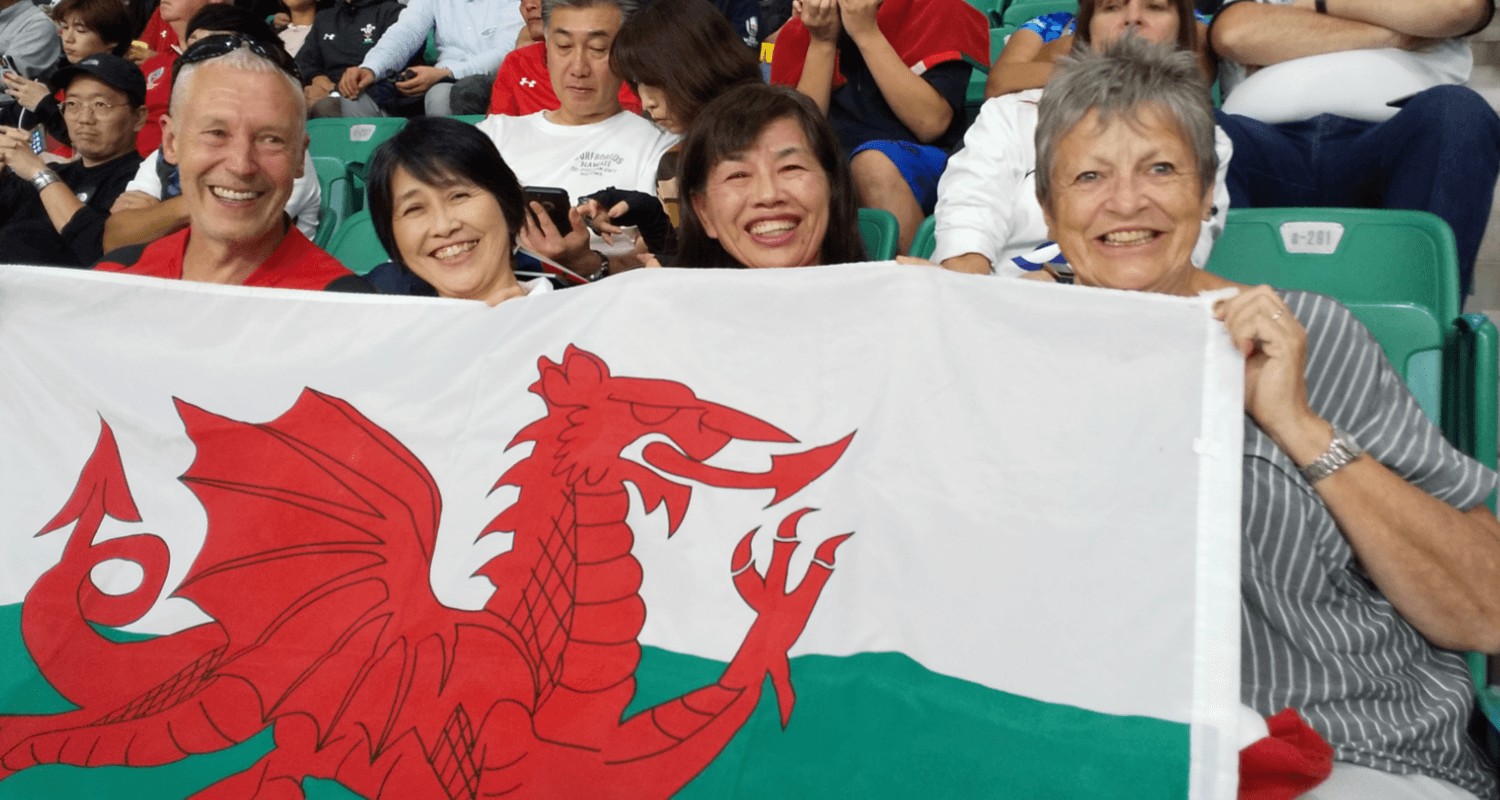
With new friends at Wales-Fiji
Thursday 10th October: Nagasaki
Didn’t wake until gone 08:30, following the previous long day of excitement. Shower, re-pack holdall, quick local breakfast at hotel and then brief walk to Fukuoka station for the 10.55 JR train bound for Nagasaki. In this land of patience, discipline and queues, I firstly joined the queue at the ticket office and then the queue on the platform for carriage number 2.
This train was much slower than the bullets and consequently allowed a closer look at the countryside and dwellings. Every house and every flat in each block had both a clothes line and four recycling bins on their balconies or small gardens. Such is the education and discipline toward sustainability of the Japanese people (130 million people) that recycling and conservation of electricity (no tumble drying) is to the fore of every household, hotel and office block. There was even clothes drying hanging out next to railway lines.
The first half of the journey was uneventful, but the journey became more interesting as we reached the coastline of the Nagasaki peninsula. Here the trainline runs adjacent to the coast where another of the Japan’s industries became apparent. Tall bamboo canes projected vertically upward from the shallow waters just offshore, this being one element of the extensive fishing industry for which Japan is famous and is the origins of sushi.
The JR limited express arrived into Nagasaki as stated in the Inside Japan itinerary promptly at 12:49. It is amazing that an itinerary compiled many months ago in the UK many thousands of miles away can state exactly what time each of journeys will both start and end and be so accurate.
The Richmond hotel was two kilometres form Nagasaki station and by now the temperature was 28 degrees so for the first time in Japan I used a local taxi which cost 800 yen (just over £7). The Richmond hotel is located down a very narrow, old fashioned side street in a district known as Shianbashi. The hotel was new having only opened earlier this year. I asked the charming receptionist about an upgrade to a bigger double room as a personal treat after tolerating the enlarged closets of the two previous hotels. The decision was easily made at £5 per night – the same price as one beer!
Similar to the rest of the Richmond hotel, the room was modern, clean and spacious (a result). At last the holdall was unpacked for the first time and even managed some handwashing of smaller items of clothing.
A brief snooze and then venture out into the afternoon sun for sightseeing in Chinatown, Nagasaki harbour and along the many boardwalks to a peaceful park. Apparently, the design for the boardwalks originated from the more famous wooden coastal walkways in San Francisco bay. They certainly looked and felt similar.
The street map picked up from the hotel was getting good use and allowed me to get my bearings for the remainder of the two day vacation in Nagaski. There were a number of attractions to keep visitors entertained. Stopped off for a late afternoon cuppa on the way back to the hotel as dusk was just beginning to show its golden glow over the mountains perched above Nagasaki city.
The plan for the evening was a meal in Chinatown- recommended by all guides to Nagasaki. But on arriving in Chinatown, disappointingly, the restaurants were very bright and not very welcoming so decided on a detour and take in refreshment at a couple of bars whilst considering a Plan B.
Being a seaside town with many holiday type attractions, Nagasaki is a popular tourist resort; however there were very few oversees visitors to be seen compared to Tokyo and Fukuoka. The many bars are unusual in that they are generally very small and narrow with 6-8 barstools and very little other space to stand. I was the only person it the two bars I visited whilst considering Plan B for din dins. The barmaids in both places seemed excited by the presence of a foreign customer, but conversation proved difficult and I promptly set off for a restaurant I recalled from the afternoon excursion which looked relatively attractive from the outside and had a few English words on the menu. There were a handful of locals eating to the left as I entered the restaurant and there was a peculiar aroma… perhaps smell is more accurate. I was immediately greeted by a lady and then her husband and that was it. No escaping.
The husband and wife (Mr and Mrs Mizota) proved to the owners and they seemed very proud that a foreigner considered eating at their restaurant, the Katarou. Mr Mizota ushered me to sit at a perched bar which is the typical format for many Japanese restaurants. Mr Mizota sat next to me and quickly guided me to the set menu. To be honest, I didn’t feel as if I had much choice in the matter. He stayed perched next to me for the duration of the multi-course meal. He was 74 years old and talked extensively about his life in Japan, South America and Europe working for Unicef following studying for a doctorate.
The courses were dominated by fish much of which was uncooked but tasted good in a dip of soy and crushed garlic (manager recommendation). The owners and their two staff laughed loudly as I endeavoured to finish the gravy broth with a rice spoon. Not good etiquette, but there was no chance of finishing with chopsticks so I thought it was the logical solution. Apparently not so.
At the end of the meal the three us celebrated with a toast of local wine when I told them their restaurant will become famous in Wales via a website called parallel.cymru.
The wife accompanied me to the front door and we said our goodbyes with no-one else left in the restaurant. The Richmond hotel was only a few minutes walk through the narrow backstreets of Shianbashi then, travel weary and straight to bo bo’s.
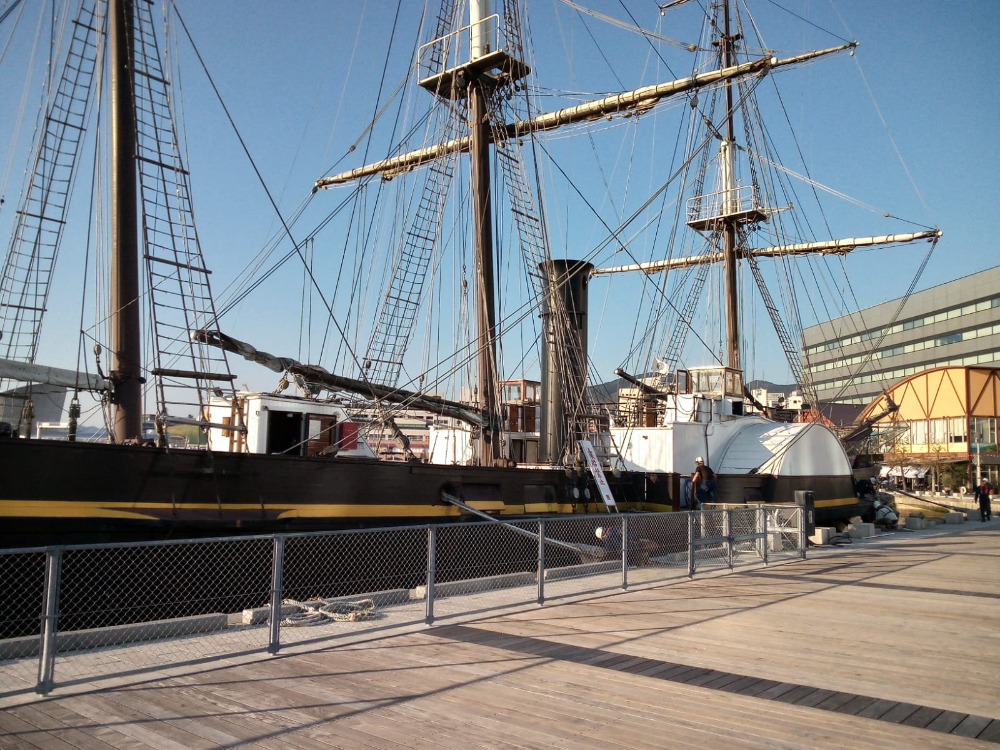
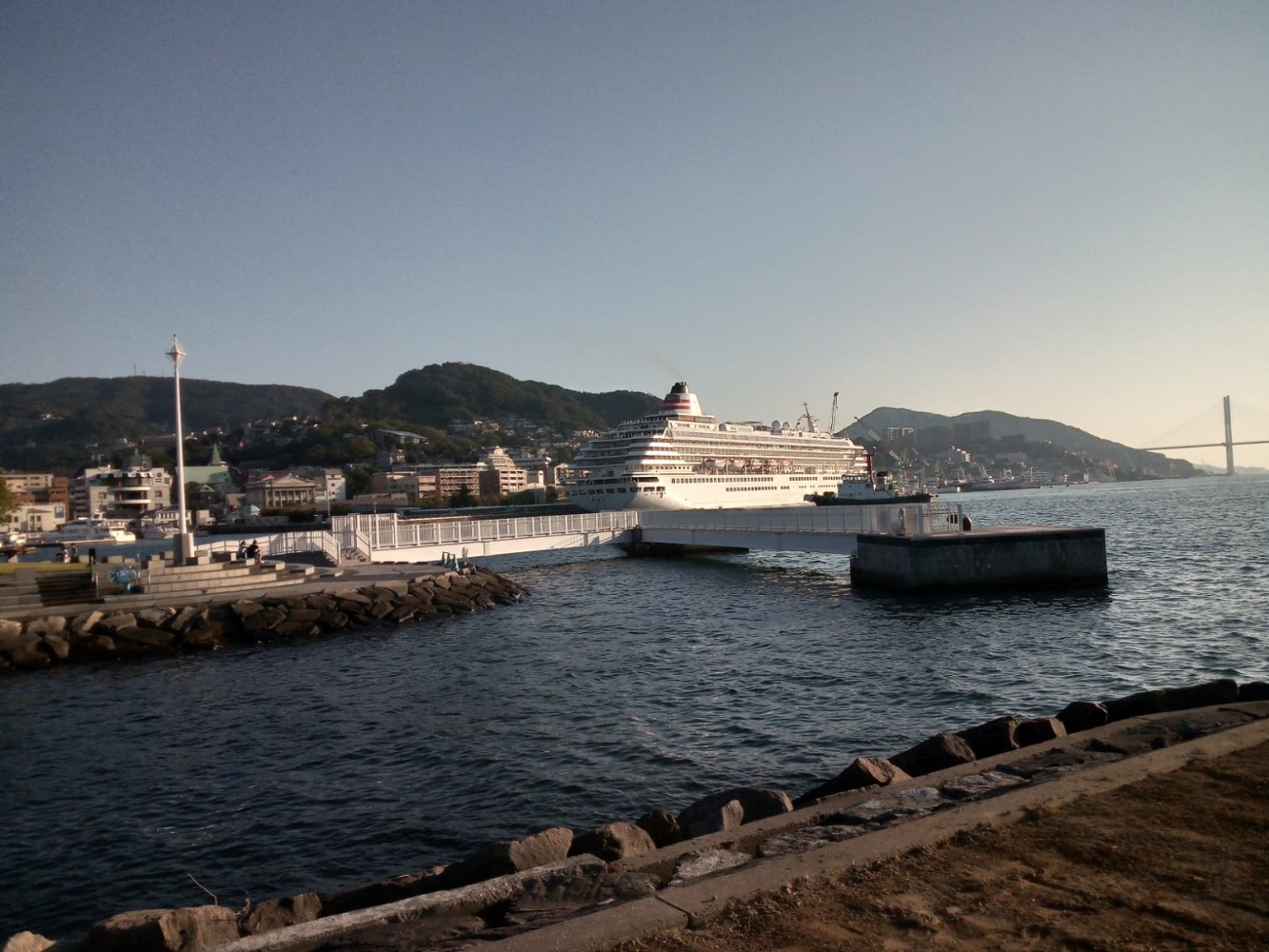
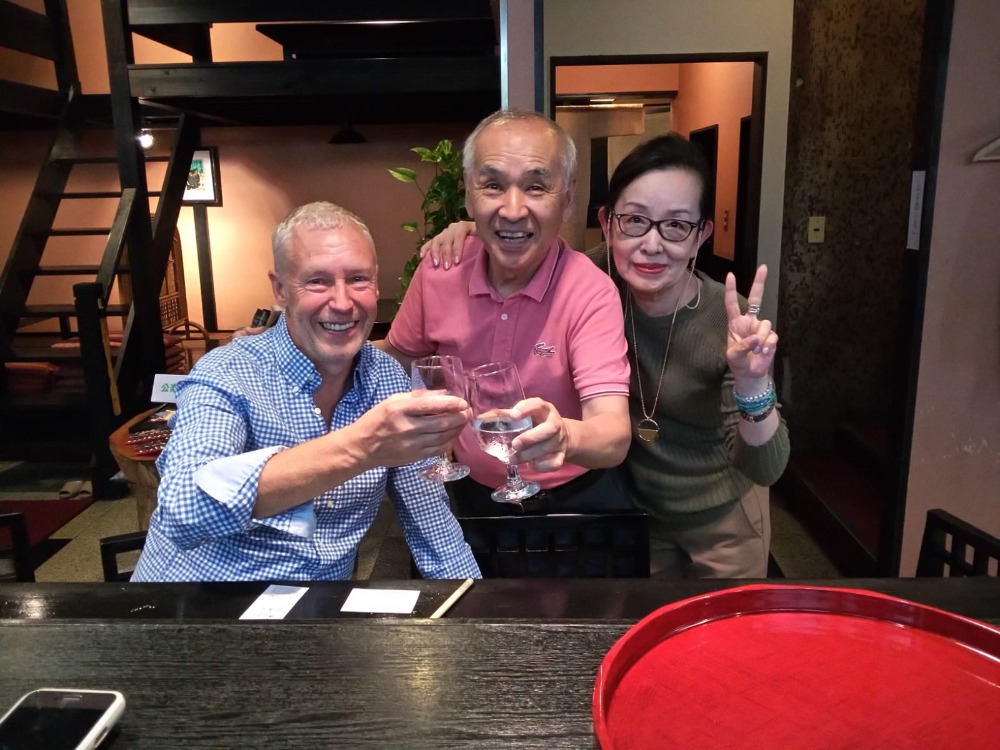
Traditional boat at Nagasaki boardwalk
Passenger liner leaving Nagasaki
Toast with owners of Katarou restaurant

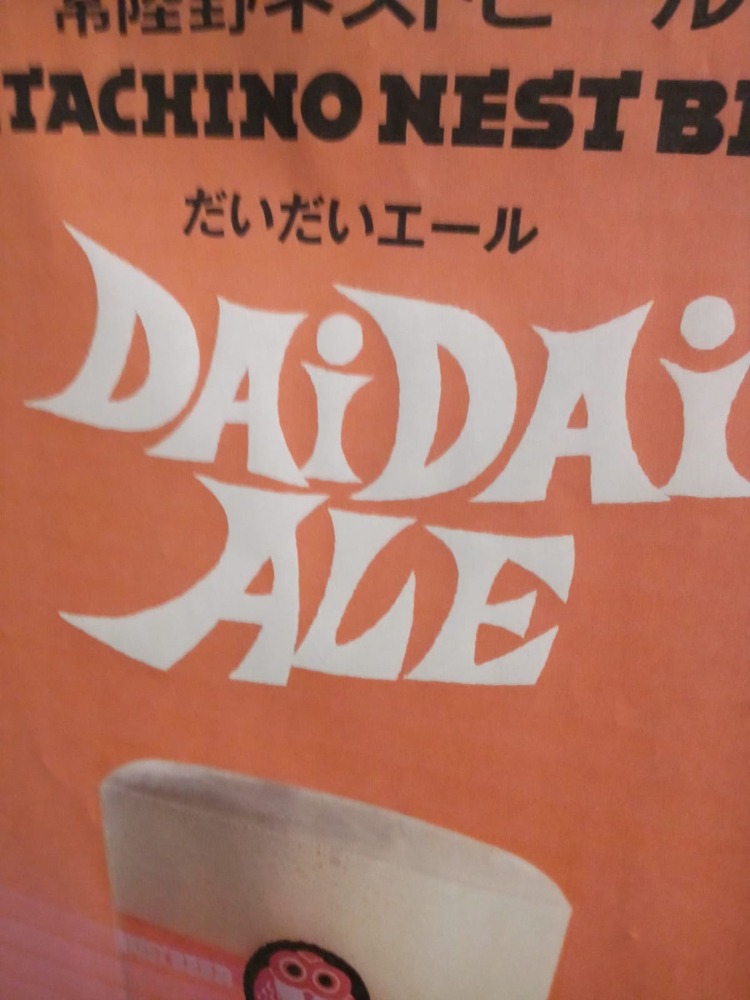
Nagasaki Chinatown
Coincidence
Friday 11th October: Nagasaki
Today is holeeeeeday in Nagasaki. Decided more exercise was needed so a route was planned to Peace Park which is about 3 miles each way. Set off through downtown Nagasaki toward the waterfront at 06:50 with map in hand. Walked along the waterfront and then north along the banks of the river toward Peace Park which took just short of an hour. A quick look around the park then head back south toward. By now the temperature was rising and feet beginning to swell; I could feel a blister developing so slowed down. Had not seen any foreigners until stopped at a road crossing waiting for the green light to appear and a couple of joggers appeared from behind one wearing a Welsh running vest. Had time to swap stories about the game at Oita before the lights changed to green and the husband and wife jogged off in front toward the waterfront and downtown. I followed some distance behind, back to the hotel for a shower then a Japanese breakfast.
Having studied the guides and visited some of the sites the previous afternoon, a decision was made to head for the atomic bomb museum which was close to the morning walk to Peace Park. The morning temperature had risen quite dramatically as I headed for the “blue” tram stop and the 25 minute ride to the station named after the atomic bomb museum.
The museum was extremely informative but also emotional. Two hours were spent looking at photographs and models illustrating Nagasaki before and after the bomb was dropped and also reading about the events leading up to the bombing and also the horrors caused. There was total devastation to the landscape and population for miles around. More than 75,000 people were killed on the morning of August 9th, 1945 and 100,000 were injured. The museum describes the horrific illnesses suffered by the injured in months and years to come. The atomic bomb at Nagasaki was dropped a few days after the first atomic bomb at Hiroshima which caused similar devastation. It is not surprising that the Japanese surrendered a short time afterward, bringing to an end World War 2.
On leaving the museum after two hours, it was difficult to take my mind away from what I had just witnessed. A walk through Peace Park where there is a memorial at the hypocentre of the bomb and then on to another park on the other side of the main road. This was the sporting centre for Nagasaki with baseball, rugby and athletic stadiums together with a 50m national swimming pool.
The afternoon temperature had reached 29 degrees as I returned on the blue tram route toward the hotel and a late afternoon tea in the welcome of an air conditioned café.
The plan for the evening was a beer and meal at the wharf area close along the boardwalk and close to the port. The wharf was a small gathering of cafes, bars and restaurants overlooking the marina. It was a 20 minute walk from the Richmond hotel through Chinatown. It was dark by the time the first beer was consumed and the wind had noticeably increased. Typhoon Hagibis was more than 800 miles away heading toward Tokyo bay but it’s effects could be felt even from this distance.
Dinner was a dish called ramen, one of the local specialities made with noodles – yum yum! The other diners were all Japanese; however just as I was leaving a couple of guys wearing Welsh rugby shirts appeared. A quick swap of pleasantries then head back past Chinatown toward the hotel in the Shianbashi district.
There was still time for a nightcap or two in a typical bar opposite the hotel. This bar was slightly larger than most with 8 barstools and also surprisingly, two tables. There were three very friendly barmen but no other clients. Apparently, the nightlife begins around midnight, which is way past my bedtime. We endeavoured a conversation, and they frequently resorted to their mobile phones for translation. One even triumphantly found the Penderyn whisky website!
Cross the very narrow street to the comfort of the Richmond hotel and off to bed wondering whether I will wake at 03:45 for the Slovakia versus Wales football match
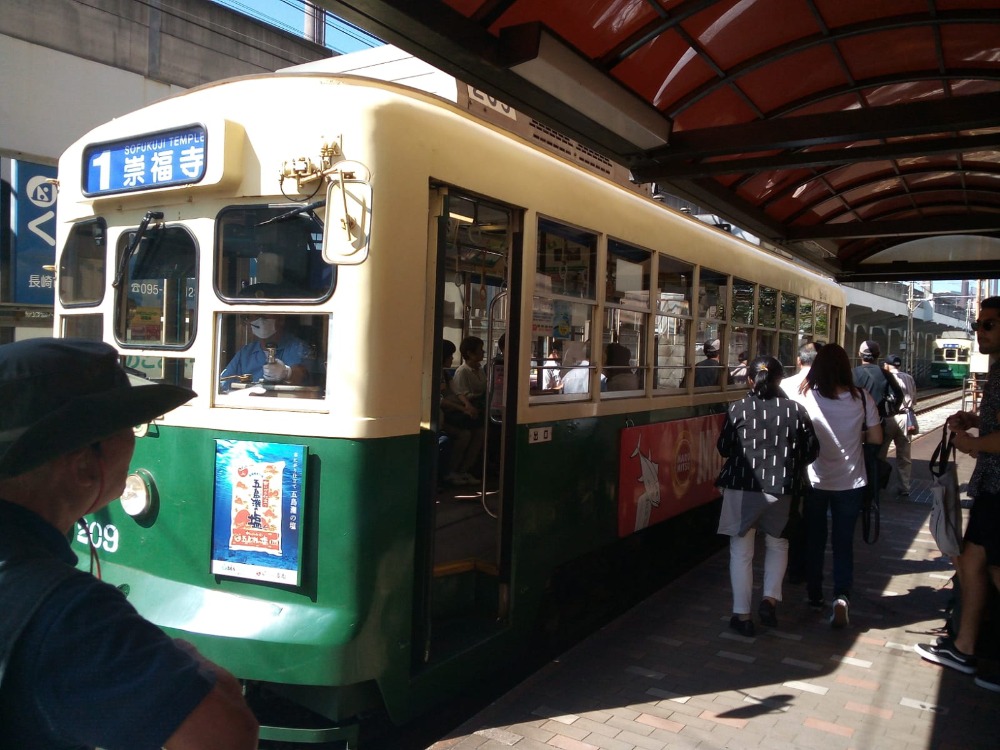

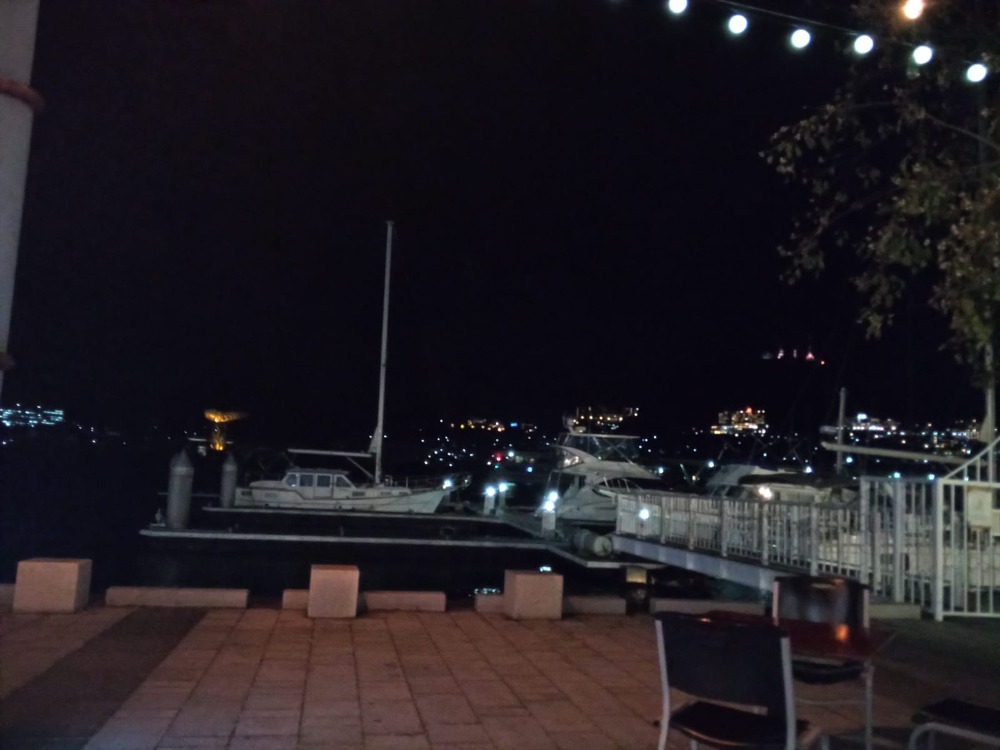
A blue Tram at Peace Park
Early morning walk at Nagasaki waterfront
Nagasaki wharf at night
Saturday 12th October: The epic journey from Nagasaki to Kumamato
The tour operator Inside Japan had complied a scenic transfer from Nagasaki to the next destination of Kumamoto, where Wales play Uruguay on Sunday 13th , tomorrow. The journey was scheduled to incorporate a tram, three buses, a ferry and a train. There was to be a sting in the tail courtesy of typhoon Hagibis.
Up at 06:30 but little packing this morning as the holdall had been forwarded to the Canedeo hotel in Kumamoto courtesy of a wonderful service provided throughout Japan. For a nominal fee, depending on size and weight, luggage can be forwarded to any nominated destination for next day delivery. Due to the complexities involved with today’s journey, this seemed an opportunity too good to miss.
There was a short walk to the tram station via an ATM inside the 7-11 store to top up cash reserves. The blue tram arrived within five minutes for the twenty five minute transfer to Nagasaki station where the first bus to Unzen would depart.
Woke up with toothache that morning and wasn’t feeling great as I searched for the bus terminus at Nagaski station. A lesson learnt during this trip is to arrive early for the start of each journey. This is on the basis that not all destinations have English signage and not all destinations are as obvious as maybe expected. Arriving early for departures is not really something that comes naturally to me as people who know me will vouch. But this adventure required a modification to normal behaviour patterns.
I asked a few random passengers where I might locate the Unzen bus. Their English was as good as my Japanese and so eventually resorted to an information desk inside the railway station. This proved to be a good move as the bus terminus was located within and beneath a brown building on the other side of a very wide and busy road and reachable only by a pedestrian bridge.
By now, and with the toothache becoming increasingly annoying, I thought seriously about the wisdom of the planned complex, scenic journey to Kumamoto or whether to be damned and take either a direct train or bus, both of which were available from Nagasaki station.
In the bowels of a warm, airless terminus, sweating and in pain waiting in the queue for the 09:05 bus to Unzen, there it was, a direct coach to Kumamoto. No, I was not going to succumb to temptation so boarded the bus for Unzen which unbeknown to me, is a mountain resort high above the east China sea and used predominantly by trekkers.
The journey took 1 hour 40 minutes passing initially through the suburbs of Nagasaki and then many picturesque villages and towns before beginning the ascent to Unzen. This was true Japan and many of the homes in towns and villages had small solar panels on their roofs, chargers for their electric cars (what a wonderful concept, to power a car from solar energy!), water butt and the mandatory recycling bins. Must mention once again the washing lines which are a work of art, some of which resemble scaffolding. The nation is so environmentally aware and disciplined. There is much we can learn in UK if we are to preserve our island in the same way.
As the bus climbed steadily toward Unzen, the wind relating to typhoon Hagibis became worryingly strong. The bus began to rock with the wind as it meandered around the hairpin bends. The pine trees on the mountainside swayed in what was now becoming a gale force wind. There was much tree debris blown onto the road. I was becoming concerned about whether the ferry scheduled for the afternoon would be sailing in such conditions. Luckily internet was available. Having located the number of the ferry company on my itinerary I called and eventually was put through to somebody that spoke English. The ferries were still running at 10:30 but if the wind increased any further, then I was told that for safety reasons they would be cancelled for the day. My crossing to Kumamoto was scheduled for 15:30.
The scenery was dramatic as we continued the climb toward Unzen mountain station. The smell of the sulphur from the steam rising out of the hot springs was pungent. The trees were swaying even more now as concern grew greater about the safety and comfort of the impending ferry crossing. Time to consider alternatives. One possibility was to turn around at Unzen and retrace tracks to Nagasaki. Other possibilities were taking a train or bus from somewhere close to Unzen or Shimabara ferry port onto Kumamato.
Unzen is an attractive mountain resort typical of many in the Alps together with log cabins and stylish retreats. The bus station was a very small building and it quickly became obvious that the lady behind the counter spoke no English. My best friend, Google, advised me that it was indeed possible to take a train journey from Shimabara to Kumamoto. The journey required three different trains and took more than three hours, but at least there was a realistic option to the ferry crossing to Kumamoto.
I boarded a local bus at 11:15 from Unzen mountain resort heading to Shimabara port and apparently thereafter to Shimabara railway station. The bus descended, tackling hairpins and with the wind howling through the gap under the front entrance. This local bus swayed even more than the previous coach. After more than 40 minutes of the descent, the harbour and sea came into view as did two boats rocking quite violently on the water. It was approaching midday; my ferry booking was for a 15:30 crossing.
Inside Japan had scheduled a few hours break at Unzen to walk through the nature reserve taking in the volcanic springs. This opportunity was declined with the strong winds blowing debris from the pine trees and the uncertainty of the journey.
As the bus pulled into Shimabara harbour a decision had to be taken quickly. Do I get off and hope the 15:30 ferry would sail across the choppy channel to Kumamato or should I stay on the bus in the hope it stops at Shimabara railway station where Google stated a local train leaves at 12:18 heading north to a mainline station. I wimped it, stayed on the bus ,which after a further 5 minutes pulled into a stop and the driver ushered me to get off. There was no train station, this was a bus terminus. Luckily one chap inside the terminal spoke a smattering of English and relayed something to the driver who by now was laughing at me in a not very pleasant manner.
Conscious the time was getting closer to 12:18, the bus pulled away from the bus terminal with only myself and the not so sympathetic driver. A further 5 minute drive through the streets of Shimabara which can be best described as a typical dirty port town or “dump”. At last, the bus came to a stop outside a tiny railway station and only one platform. I showed my 10 day green railcard and in sign language was advised this was a local railway line and green travel cards were not valid. Bought a ticket from the ticket office with the one carriage diesel train waiting on the only platform. The train reminded me of those used on the Valley Lines 40 years ago.
Obviously the only non-local person inside the very basic carriage, I sat opposite an old lady who was eating little bread rolls with no filling. I resorted to the iPod in an attempt to relax and take stock of the situation. The train travelled slowly due north along the coast stopping at tiny stations on the way. There was only one railway line with occasional passing points for the carriage chugging in the opposite direction. The railway was so close to houses we could look through their windows. The passengers from these coastal villages were obviously not as wealthy as city dwellers.
After an hour and twenty minutes journey the carriage chugged into Ishaya station which ironically was only two stops or ten minutes up the line from Nagasaki, where today’s journey started. It was now gone two o’clock as I boarded the train from Nagasaki to change at Shin Tose for the Shinkansen bullet to Kumamato. Beginning to breathe easier again now as Plan B conceived at Unzen and confirmed at Shimabara port was taking shape and the stress and uncertainty experienced at Unzen mountain station was a disappearing memory.
Arriving at the large Kumamoto station I hunted a pharmacy or drugstore as they are referred to. A conversation ensued with the pharmacist which involved translation sheets where “toothache” was pointed to. The powders were expensive but were a “must buy” item in an attempt item to get relief from nagging pain.
The final leg of this epic adventure was as stated in my Inside Japan itinerary, the JR Hohi mainline commuter train from Kumamato main station to Higo-Ozu. Then, a ten minute walk to the Candeo hotel where I arrived at 17:00 having left the Richmond hotel, Nagasaki at 07:30 in the morning. The Candeo is a characterless 10 storey building located along a main road amongst many car showrooms, car service bays, franchises, KFC and a few other characterless hotels.
Reunited with my luggage at reception, I checked into a comfortable but small room. Yet again not enough space to properly unpack the holdall.
All previous hotels selected by Inside Japan were city centre locations. The Candeo was in a quiet suburb of Kumamoto close to the airport and 35 minutes on the Hohi line from the city centre. This hotel proved to be contentious with some other Inside Japan (IJ) clients staying at the Candeo. The two IJ representations (Mark and Rachel, the same as those on the coach from Fukouka to the Wales v Fiji Match), explained this was the only viable accommodation available to those who booked less than nine months before the tournament as all city centre hotels had been booked 12 months in advance of the tournament. Rachel and Mark were also staying at the Candeo which seemed to appease the disgruntled clients.
I turned on the in-room TV to view the national news and the devastation being caused in the Tokyo region by typhoon Hagibis. It was 17:30 and the eye of Hagibis was scheduled to hit Tokyo at 17:40. Natrurally, I couldn’t understand the newsroom readers but could readily sense the nervousness in their voices. The news channel was dedicated to the typhoon and reporters were broadcasting from different locations in the north of the country affected by the typhoon. The TV images were horrific, and it was difficult to comprehend this devastation was happening in the same country. A friend from home in Crondall was visiting Japan and following the English matches. He was staying in Tokyo and was confined to his hotel. We exchanged messages through the evening and the next morning when calm eventually arrived once again in Tokyo.
Later in the evening, and following a short relaxation, I walked into the “old town” of Higo Ozu in search of a bar and suitable eating establishment. Old Ozu resembled what I imagine of an old cowboy town. Wooden houses with a few small eateries hidden behind wooden sliding doors. Sliding open and peeking into the small restaurants, locals were sat on cushions on the floor eating with chopsticks from very low tables. Continuing my so far unsuccessful walk, I came across an unattractive three storey concrete building. There were a couple of the previously described restaurants on the first two floors and I then entered what was apparently a wood panelled steak restaurant with proper sized tables and younger clients sitting on proper sized chairs. I asked if it was OK to order a beer and was shown to a table by a friendly bar lady.
Following the trauma of the 10 hour journey from Nagasaki and in time honoured fashion the first two beers didn’t touch the sides of the glass and a lovely relaxed feeling engulfed me.
Whilst walking from Ozu station to the Candeo hotel along the main road earlier in the evening, I caught a glimpse of an Indian Restaurant which was clocked as a possibility for this evening’s meal. It was to become my next port of call. Inside the restaurant was a combination of low-down and proper-size tables and only a smattering of people. The food was excellent as were the two large bottles of local beer.
A five minute walk back to the hotel, administer the painkiller then send a message to my beloved before much needed sleep and look forward to tomorrow, another match day for the Welsh team.
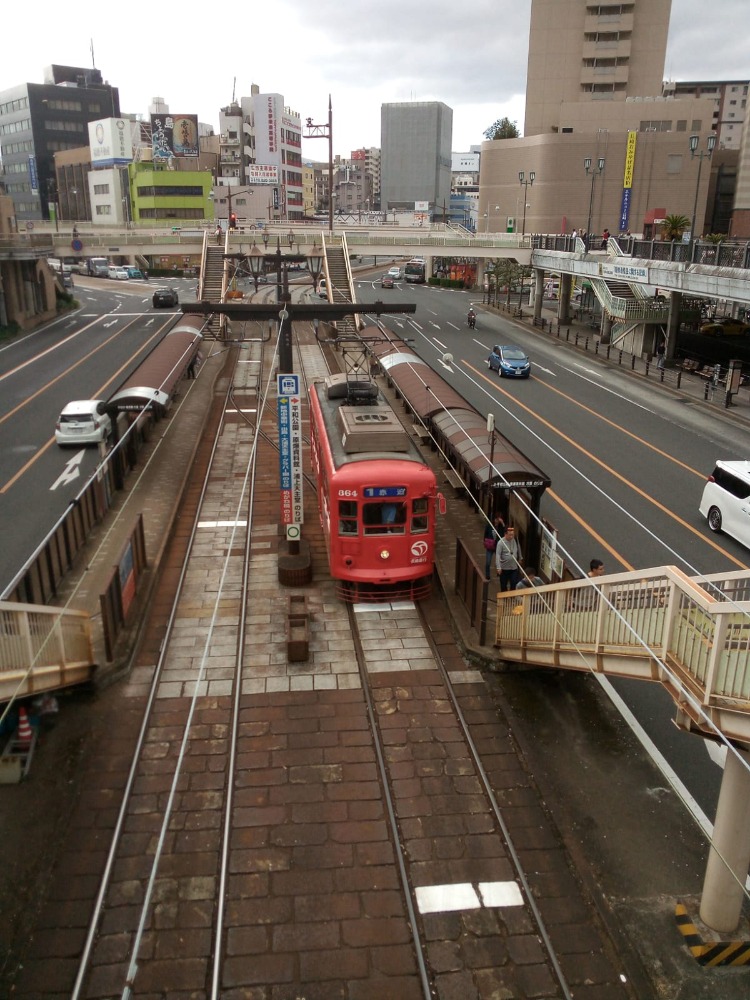


A Nagasaki blue line tram
Unzen mountain resort
Local one-carriage chugalong from Shimbara
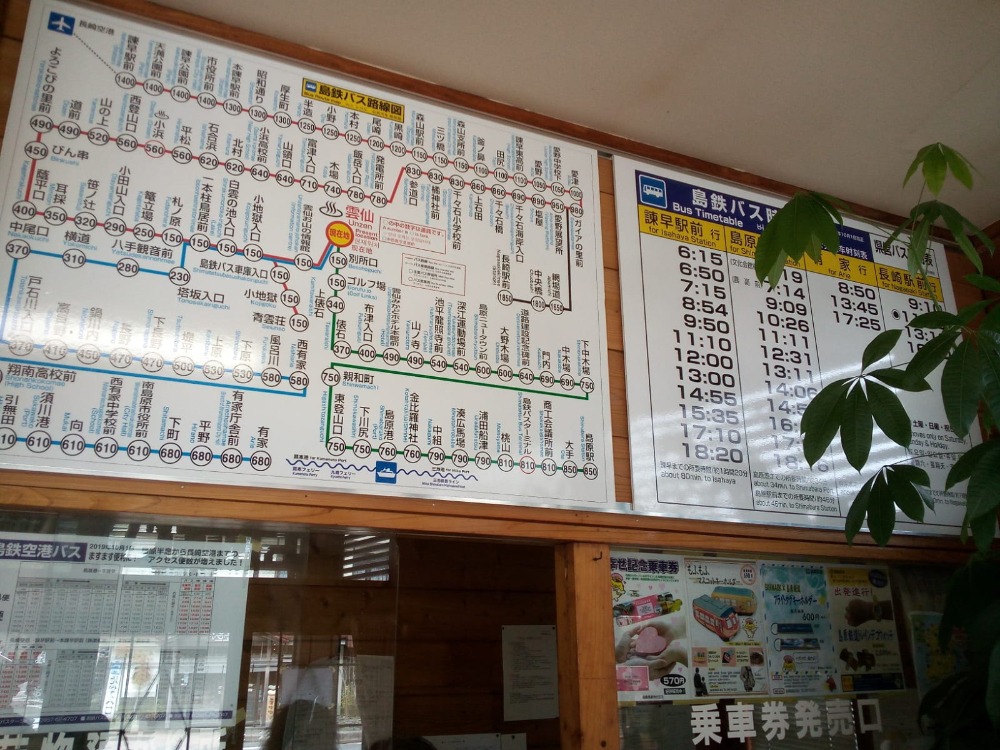

Bus timetable at Unzen
Bullet train bound for Kumamoto
Sunday 13th October: Matchday in Kumamato- Wales vs Uruguay
Woke up around 6ish but the sun had beaten me to it. A stunning, sparkly day with temperatures set to reach 28 degrees later. Decided that some exercise was needed and had seen a couple of rickety old bikes in the hotel entrance that guests could borrow.
Down to reception, unlocked one of the really heavy, rickety bikes then out into the glorious sunshine. Just like all the other cyclists, I stuck to the pavements alongside the main roads and the resorted to the roads where they weren’t so busy, and it felt safe to do so. Not much to describe except a few shrines, paddy fields, other crops and typical suburban houses. The rural smell of the farms was strong and was somewhat refreshing following the many days spent in developed cities.
Back to the hotel, shower, then down to the café area for a Japanese savoury breakfast. There were a few other Welsh fans milling around in the small breakfast area as well as Rachel and Mark from Inside Japan. Got chatting to Mr and Mrs Francis who originate from Port Talbot, but now live just outside London. Mr Francis used to be a rugby referee in his younger days and was certainly very knowledgeable of the sport which became obvious as we chatted about the tournament so far. We discussed our mutual plans for the day and quite by chance we would meet up again at lunchtime.
My aim was to take the Hohi line into Kumamato city centre for some sight-seeing and also to experience the atmosphere in the vast city on match day. Kick off was 17:15 in the afternoon so plenty of time to explore- or so I thought.
Kumamoto mainline station on that glorious Sunday reminded me so much of match days at Euro 2016- Welsh fans wearing red shirts were meandering aimlessly around the city, probably waiting for the bars to open. Other Welsh fans were still arriving in large numbers at the station together with their luggage. So many rugby fans coming from all over Japan! Each with their own itinerary and story to tell- and every one different. The logistics of such an event are mind boggling.
The plan was to board one of the more modern trams than Nagasaki and venture to the castle, this being Kumamoto’s most famous visitor attraction. This plan was scuppered by a 200metre long queue in the sunshine at the tram station. The fallback was to stroll around the city close to the station whilst taking in the matchday atmosphere which by now was noticeably increasing. Found a coffee shop and enjoyed an iced latte chatting with some other fans looking over the main road which had a definite red tinge.
The station for the shuttle buses to the stadium was on the same Hohi commuter line as the Candeo hotel. The shuttle bus stop was 20 minutes from Kumamoto main station whereas as Ozu was 15 minutes further on. Around midday, I returned to the hotel for a blog writing session in the small hotel reception area after firstly changing into the requisite Admiral Wales rugby shirt. On the train back to Ozu, Welsh fans together with their luggage were getting off the train, obviously headed for their overnight accommodation.
Back at the Candeo, a few supporters had already begun drifting out of the hotel headed for the stadium. Met up with Mr & Mrs Francis once again who had also changed into their rugby shirts in readiness for the match. They were intrigued by Parallel.cymru and the diary and became new recruits to Parallel.cymru.
Rachel and Mark were also in the hotel foyer. They had been working all morning rescheduling more than 70 of their clients who had been disrupted by typhoon Hagibis. In total, Inside Japan had arranged itineraries for approaching clients attending RWC2019 from many of the participating nations. With that part of their job completed for the day, they now had to continue their work at Hosi station and the shuttle buses where they would greet as many of their clients as possible. They were both wearing their white and green company outfits so were easy to pick out.
At 2ish, daily blog completed, it was time to head to Kumamoto stadium. A 10 minute walk to the station and then a short ride to Hosi where we meet the thousands of other fans coming the other way on the Hohi line from Kumamoto centre. It was 27 degrees by now so stopped at the nearby 7-11 for a bottle of water and some savoury munchies. These were eaten discreetly as food should not be consumed in public places but the munchies were needed to line the stomach before further pre-match refreshment.
Boarded the train at Ozu with a few other Welsh supporters then got off at Hosi station where we joined the massed hoards arriving from downtown. A red snake slowly made its way down the steps and out of the station. High fives with Mark and Rachel as the snake meandered its orderly way toward the shuttle bus stop. There were a few mini markets on route where some of the crowd broke rank with the snake to purchase cold tinnies. It was hot after all! There was much joviality, swaps of stories and thoughts for today’s match
Tens of shuttle buses waited at the large, open car park and it took no time to board. A Japanese rugby fan sat in the next seat and we talked all the way to the stadium. Hilariously, he showed me a song sheet of the Welsh National Anthem and Calon Lân translated into Japanese. He proudly told me that he was one of the 15,000 Japanese rugby fans that famously attended a Welsh training session a couple of weeks before the tournament started.
Getting off the bus, we were each given a voucher to remind us which queue to join after the match for the shuttle bus to return us to Hosi station. Ours was queue A, with the letters going up to M for each of the other shuttle destinations. This was a huge logistical exercise, similar to that at Oita stadium the previous Wednesday. There was a 20minute walk from the shuttle bus stop through a picturesque park to the stadium. Entertainment was being performed along the route, with dancers, drummers and even a small group of singers. It was very hot, so shelter was sought under trees wherever possible. Signs directed us to the back of the queues for each of the four entrance gates. The queues leading to all four gates were lengthy. We had been warned that that security would be tight, which certainly was the case.
What a coincidence- whilst queuing I was stood immediately behind the lady who I’d sat close to at the Fiji game in Oita. Her husband, the S4C commentator Wyn Gruffydd, needed to be at the stadium four hours before kick-off. The lady had been passing time with Suduko puzzles in the nearby park.
We passed through Gate 2 and then time to say goodbye as her seat was in sector Z with mine in sector C. The first tranche of refreshment booths located immediately after the security gate were beckoning. It was time for the first beer of the day which was enjoyed in glorious sunshine.
There was still 90 minutes to kick-off. I swapped messages with an ex-colleague of mine, Elwyn Jones – no prizes for guessing his nationality. I’d last met Elwyn in Bordeaux who at that time was with his nephew for the Welsh matches at Euro 2016. This time he was with his wife, Sheila. We had been communicating throughout the week and the only time our itineraries coincided was at this match. We agreed to meet up before the match at a mutually convenient location. However, Elwyn and Sheila had firstly been caught up with the crowds travelling from Kumamoto city and were now in a much lengthier queue than mine outside gate 4. The meeting was not to be. Let’s hope Wales qualify for Euro 2020, then perhaps we meet again.
Into the stadium with refreshment in hand. Both teams were going through their pre-match routines. I sat amongst a group of friendly Kiwis who rapidly removed the Welsh flag which had been draped over their seats. Shane Williams was being interviewed immediately in front of us on the perimeter of the pitch. The interview could well have been with S4C as he is well known as a fluent Welsh speaker; I certainly didn’t recognise any ITV interviewers.
Shane then walked to the touch line and briefly spoke with a couple of ex-team mates. He knew the protocol so didn’t encroach onto the field of play.
Time for a bit of name dropping. A couple of years ago I was invited to a Victor Ubogu (VU) sponsored celebrity golf day at a prestigious golf course in Buckinghamshire. I was invited by the same friend who yesterday was confined to his hotel in Tokyo. Shane Williams was playing at the VU golf day and Andy introduced me to Shane, who insisted I sat next door to him for the pre-round breakfast. A photograph hangs proudly on the wall in my study. What a lovely, friendly, family guy; a genuine gentleman which is possibly one of the reasons he gets so many media opportunities.
Kick-off was now thirty minutes away and thankfully the sun was setting behind the stadium and the temperature became much more comfortable. However, the teams were still going through their pre-match warm up which grew in intensity as kick off approached.
Time for the anthems. The Japanese pulled out their song sheets and made an excellent effort to join in with the Welsh National Anthem.
The game itself was a poor spectacle, although the Kiwis were good entertainment, and cheering every attacking move from both teams. On this performance they don’t fear playing Wales even though we appear as number 2 in world rankings. Wales ended up winning quite comfortably and have made it through to play France in the quarter finals.
Many of the fans were leaving the stadium with ten minutes of the match remaining, their aim to watch the Japan versus Scotland match scheduled to start in less than an hour following the conclusion of the Wales Uruguay game. The issue of match scheduling was discussed with Mark and Rachel who stated that the tournament organisers had not allowed enough time between matches that are played on the same day. Official RWC2019 Fanzones have been set up in all cities hosting matches. However there is not enough time between matches for fans to get to the Fanzones and watch a second match if they have attended the first match.
Still inside the stadium and sensing the queues at the shuttle bus park were going to be lengthy, I stayed behind listening to the post-match interviews and subsequently watching the players seek out their families in the rapidly-diminishing crowd.
I sauntered back to queue A at the shuttle bus stop hoping it would have evaporated by now. No such luck and I joined the rear of a huge winding queue which took just over an hour to board the bus. No worries, as there was lots of entertainment in the queue. I was amongst a group of Welsh speakers who were joyously singing songs I recalled from school days, including a full rendition of Max Boyce’s Hymns and Arias- every verse. Also chatting to a lady, much the worse for wear, who knew my home village of Caerau. Apparently her mother still lives in Carmen Street where my twin brother used to deliver newspapers as a teenager.
The most entertainment was provided by the locals who were streaming the Japan versus Scotland matches live on electronic devices of varying sizes. Technology is amazing. Scotland took the lead and there were loud boos in the queue. Then the impossible happened and Japan, who were playing superbly well, scored a succession of tries. Everyone in the queue who wasn’t singing gathered around one of the many mobile electronic devices to watch the miracle that was unfolding. There were rhythmic chants of “Nippon” (Japan in Japanese). It was halftime as we boarded our bus and then a 15minute walk through the moonlit night to Hosi station and the short train ride to Ozu.
The platform for the trains heading downtown was crowded, the platform for Ozu not so. Another coincidence- on the platform waiting for the Ozu train, I met up once again with the Francis family from Port Talbot who were also staying at the Candeo hotel. On the train, I told them of my intention of visiting the steak house where the previous evening I had enjoyed a couple of beers and intended to do the same tonight. I’d noticed a TV screen in the steak house and hoped that they might be playing the end of the Japan versus Scotland match which by now was getting exciting as Scotland were pegging Japan and could overhaul them for a quarter final. Much was at stake.
Mr and Mrs Francis followed me into the steak house where indeed they were playing the Japan versus Scotland match. Mark and Rachel from Inside Japan were also in the bar with a couple of other clients also staying at the Candeo. It was an enjoyable end to a memorable day and Japan held on to qualify ahead of Scotland for the quarter finals.
There was time to stop off at 7-11 and pick up a late night snack to munch in the hotel room before tooth medication, messages then night nights.
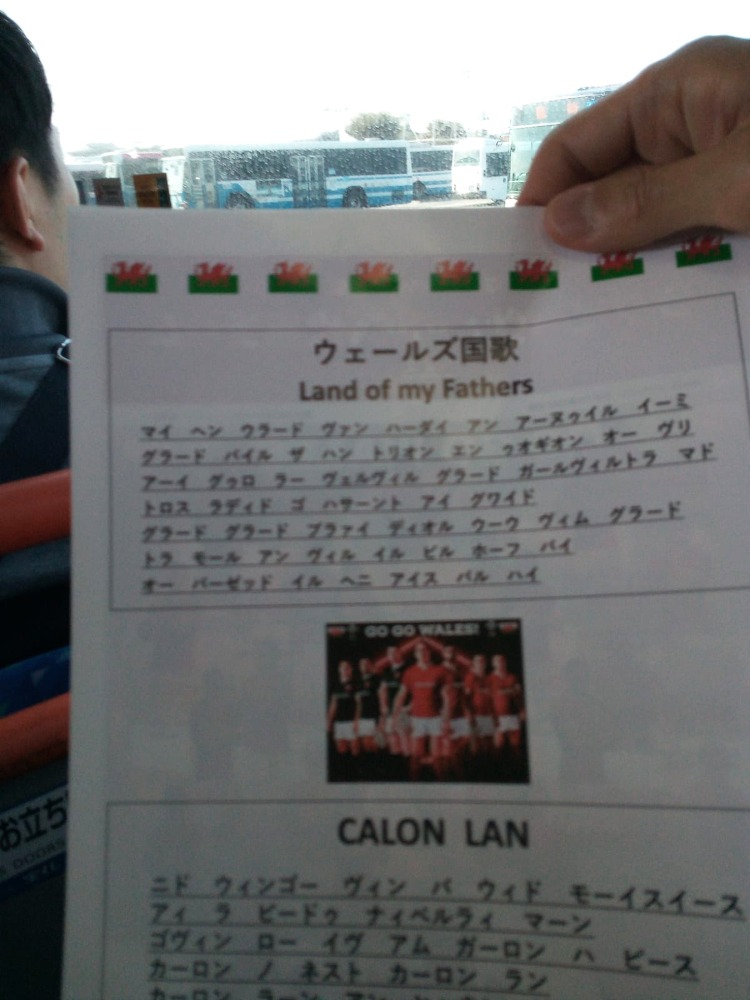
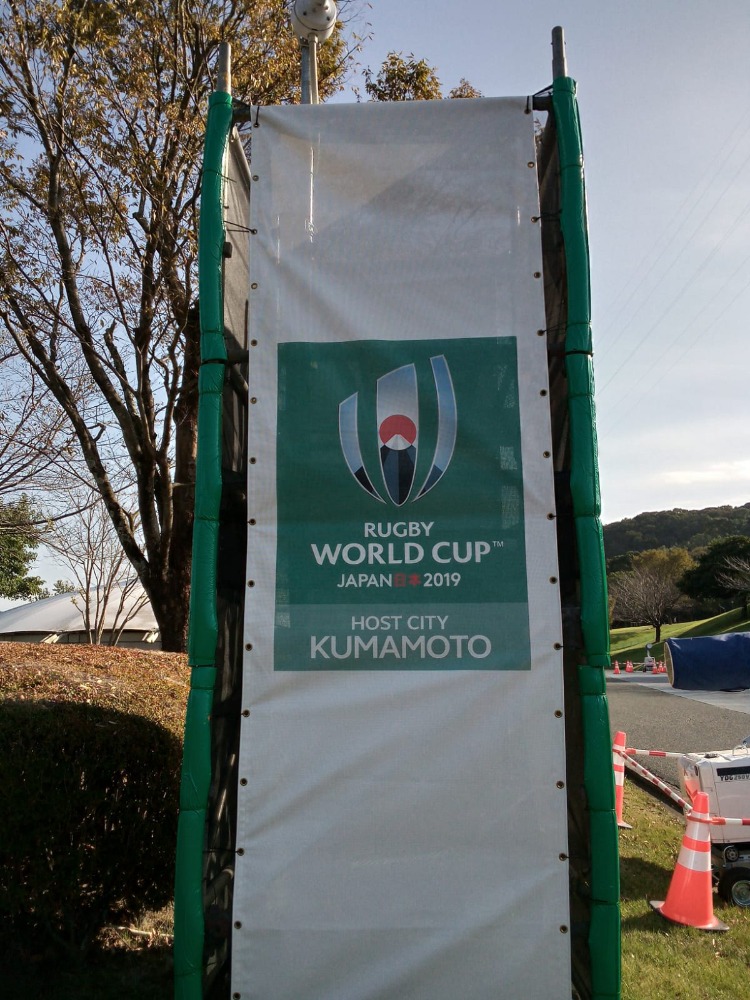
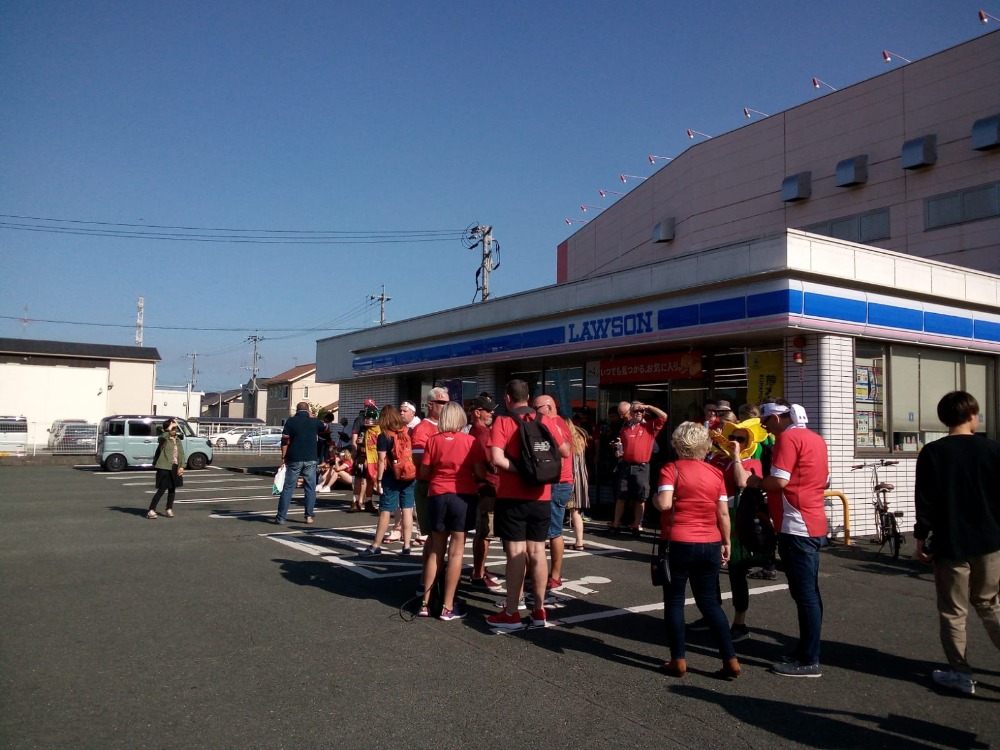
Song sheets such the locals could join in the singing
The walk from shuttle bus to stadium
Welsh fans purchasing liquid refreshment
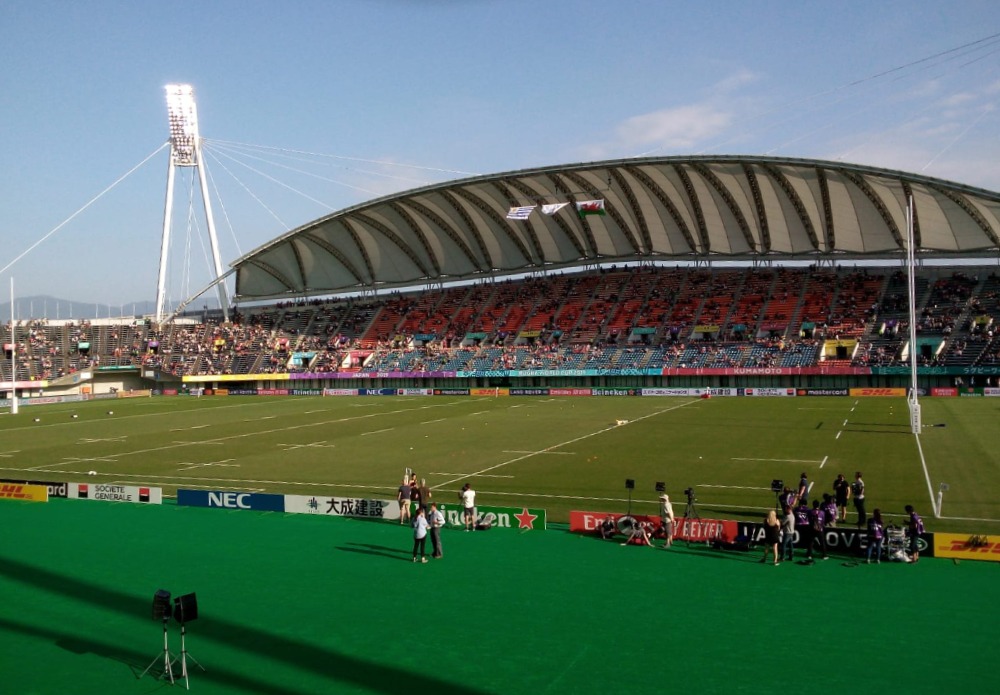
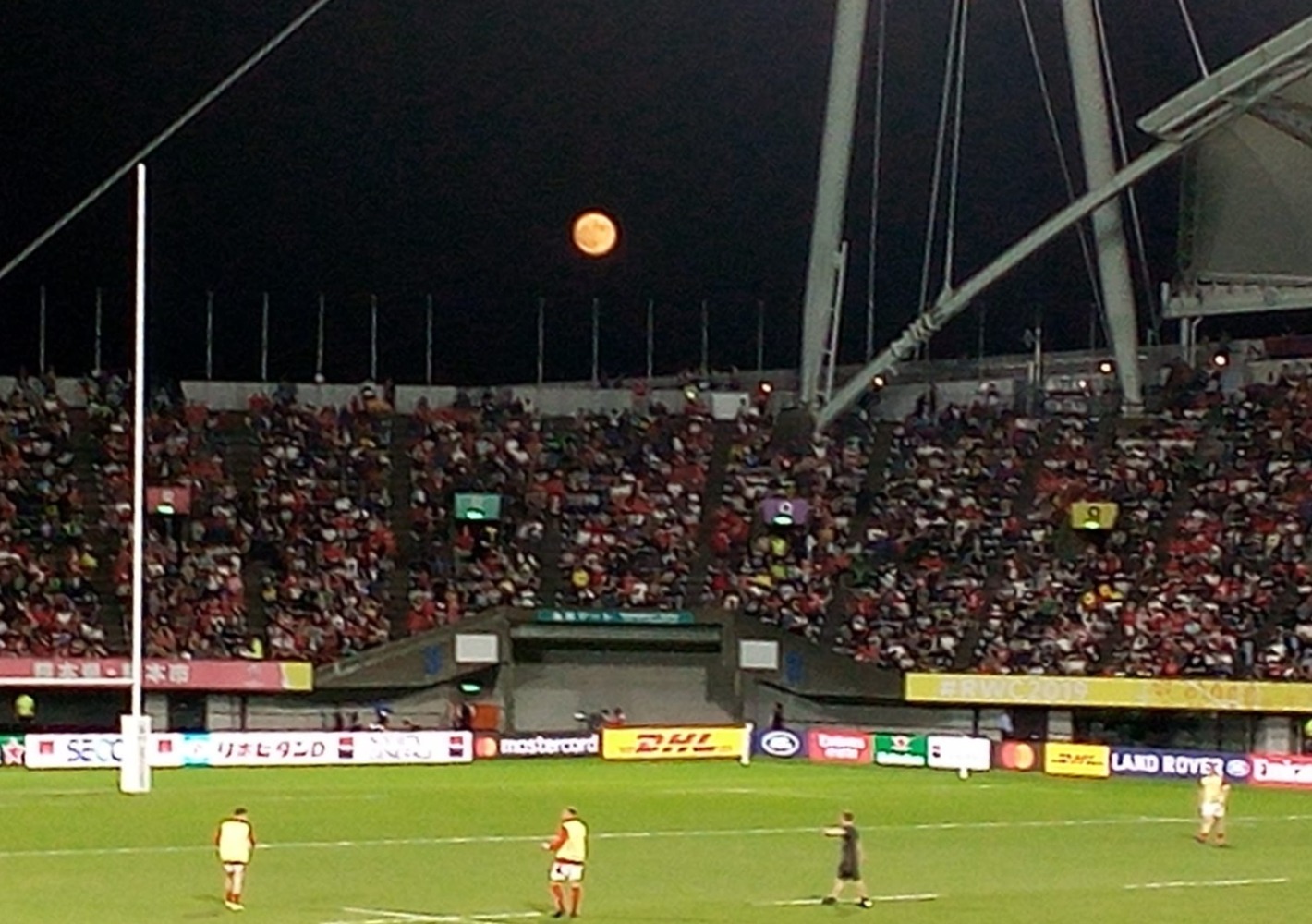
Kumamoto stadium in glorious sunshine
Moon rising over stadium in second half
Monday 14th October: The long journey home
The alarm was set the previous night for 06:30, but I awoke at 05:00 out of a deep sleep following the previous day’s excitement. Remembering that Wales were playing Croatia in a EURO2020 qualifier which kicked off at 0345 local time, I turned on the mobile phone and followed the game on BBC Sport. The match ended in a 1-1 draw at 05:45. It wasn’t worth attempting more sleep so got up, shower and then pack the holdall ready for the 800mile journey to Tokyo for the last night sleep in Japan.
Consumed a small breakfast and strong coffee with a surprising number of Japanese folk in the hotel café at this early hour. Unsurprisingly, there were no Welsh fans at breakfast yet- probably jaded following their previous day antics in the hot sunshine.
The sun was shining once again although the temperature was cool as I walked one last time to Higo Ozu station and the 07:44 commuter train heading for Kumamoto. A number of schoolchildren joined the train at different stops along the route, but no Welsh rugby fans.
Kumamoto main station was busy in the middle of rush hour but nowhere near as manic as Tokyo. I headed for the Shinkansen bullet platform to board the 08:50 headed for Shin Kobe. Shinkansen is the main rail franchise between Tokyo and the islands to the south of Japan. In some of the larger stations, the Shinkansen franchise have their own platforms, such is their dominance in these parts. The first stop on this Shinkansen bullet was Fukuoka where I’d stayed the previous week, but it felt a lot longer than just a few days ago, then a change of bullets at Shin Kobe heading to Tokyo.
A big element of Japanese culture is their politeness, in particular bowing, either as a gesture of hello or thank you. Every time a ticket collector or other member of the train’s staff entered a carriage, they would stop at the door and politely bow. The same action was repeated when they left the carriage. On each carriage outside the seating area was a clean toilet and also cubicles for making telephone calls which were not allowed in the passenger seating areas. There were also the mandatory recycling bins.
At each station along the route, rugby fans of different nationalities were either boarding or disembarking as they were continuing with their own unique itinerary. There were a few Welsh fans, who similar to myself were taking the 6.5 hour journey to Tokyo. Swapped messages with my ex-colleague Elwyn who was heading for his last night in Osaka before flying back to UK on Tuesday night.
Whilst sat in the comfortable reserved seat on the Shinkansen bullet, I contemplated with some disdain my last night of this epic adventure back at the student type accommodation of the Ibis hotel in the manic Tokyo district of Shinjuku. Using the efficient bullet train wi-fi, I searched and treated myself to a different and more luxurious hotel in a less manic district of Tokyo. My nieces would be amazed that their technophobe uncle was capable of booking a hotel room in Japan whilst on a train journey! There were excellent offers available for last minute bookings and so made a heavily discounted reservation at the Park Royal Hotel in Nihonbashi.
It was raining as the bullet headed north through Japan for on time arrival at 15:50 in Tokyo main station. I looked for any obvious damage caused by typhoon Hagibis. None was to be seen and the authorities had been super-efficient in their clean-up operation.
The Royal Park Hotel was located in the Nihonbashi district of Tokyo which was 2km from Tokyo station. It was raining and there was no easy metro route to Nihonbashi without at least three stops, so I boarded a taxi for the 10minute ride.
The entrance to the Royal Park Hotel was enormous and very grand with large chandeliers, marble floors and sweeping staircase. The double room was spacious had even had a wardrobe- the first of the journey. I joyously unpacked the holdall and took great pride in hanging my clothes. There was a wrinkle free spray which I used with great enthusiasm!. There is more- the channels on the in-room TV included BBC News and there was a mini bar.
Having made a cup of coffee whilst catching up with the latest news and getting my bearings with the various district guides, it was time to head out and seek dinner. The hotel was fantastic but so were it’ prices for food and beverage. In fact I couldn’t believe the style and quality of the hotel for the price charged, which was 25% of the tariff quoted at the lengthy reception counter.
It was raining, so borrowed an umbrella from the concierge. There certainly was not a bell boy at any of the other hotels on this trip. Out into the Tokyo night and some exploring.
Nihonbashi is close to the banking district and Tokyo stock exchange, and the contrast in atmosphere to the zoo-like Shinjuku was immediately obvious- this area was calm and much more professional. Commuters didn’t seem to be as rushed and there was more space at ground level, even though surrounded by modern high rise offices and apartment blocks.
Decided on a small bar for a couple of beers before moving to an unusual boutique grill for dinner. The seating in Japanese restaurants differs from the West- they seat on benches with a perch in front of them for their bowls of food, whereas in Europe we sit around tables. Sat at my perch, the chef prepared a dish of three types of grilled meat, but as with their fish, the meat is not cooked to the same extent as we would. I wasn’t brave enough to try one of their speciality cocktails – tomato juice and beer! Why?
Back out into the rainy Tokyo night, it was close to 10pm so time to head back to the luxurious Royal Park Hotel and an enormous bed which wouldn’t have fitted into the rooms at the Ibis, Richmond or Candeo hotels.
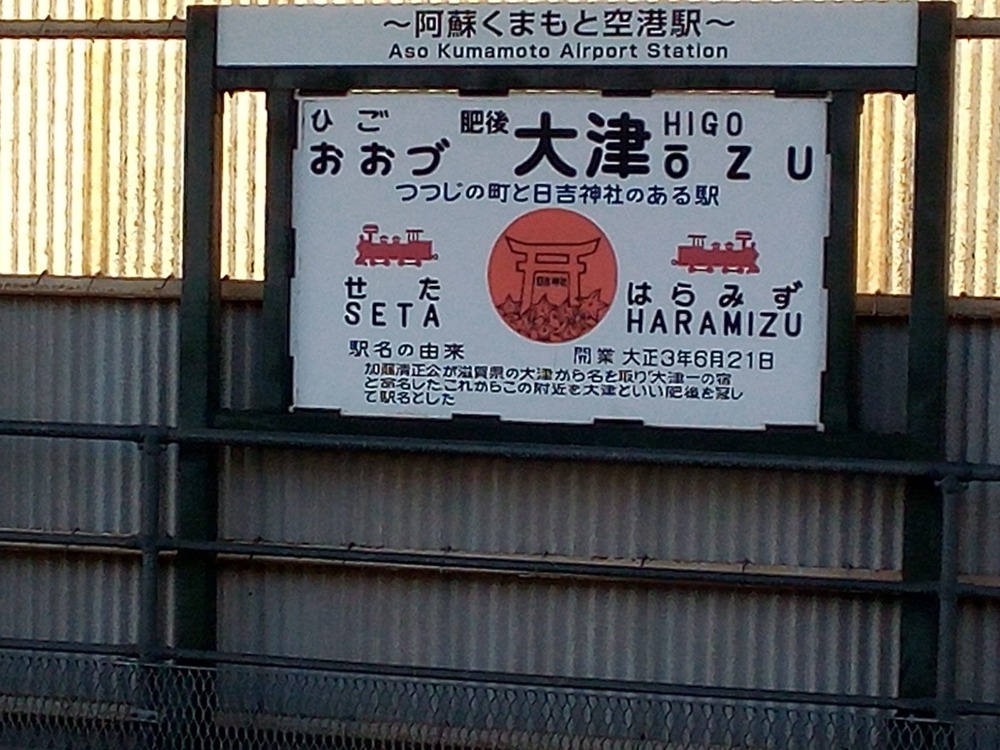
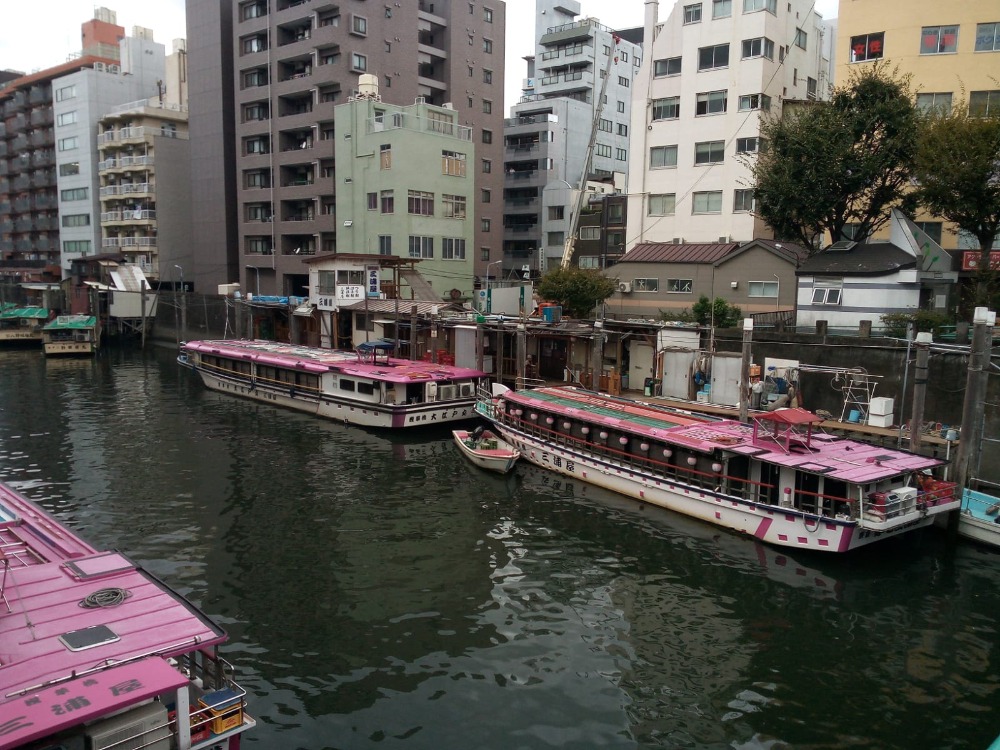

Hugo Ozu station- Homeward bound
Tourist boats on a Tokyo River
View from Tokyo hotel room
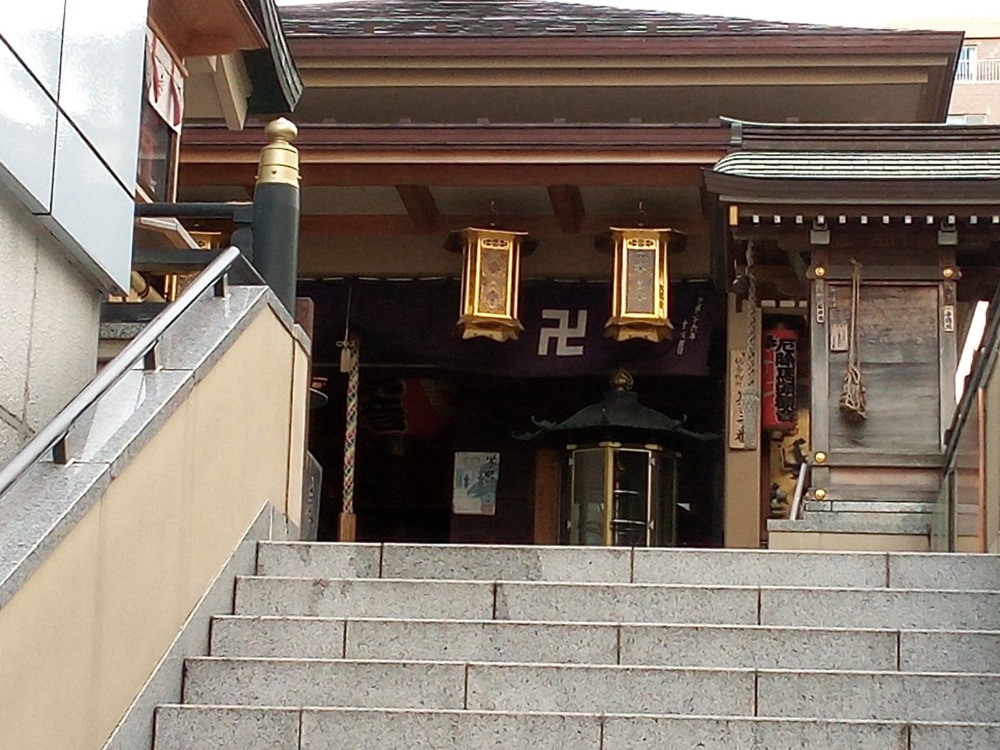

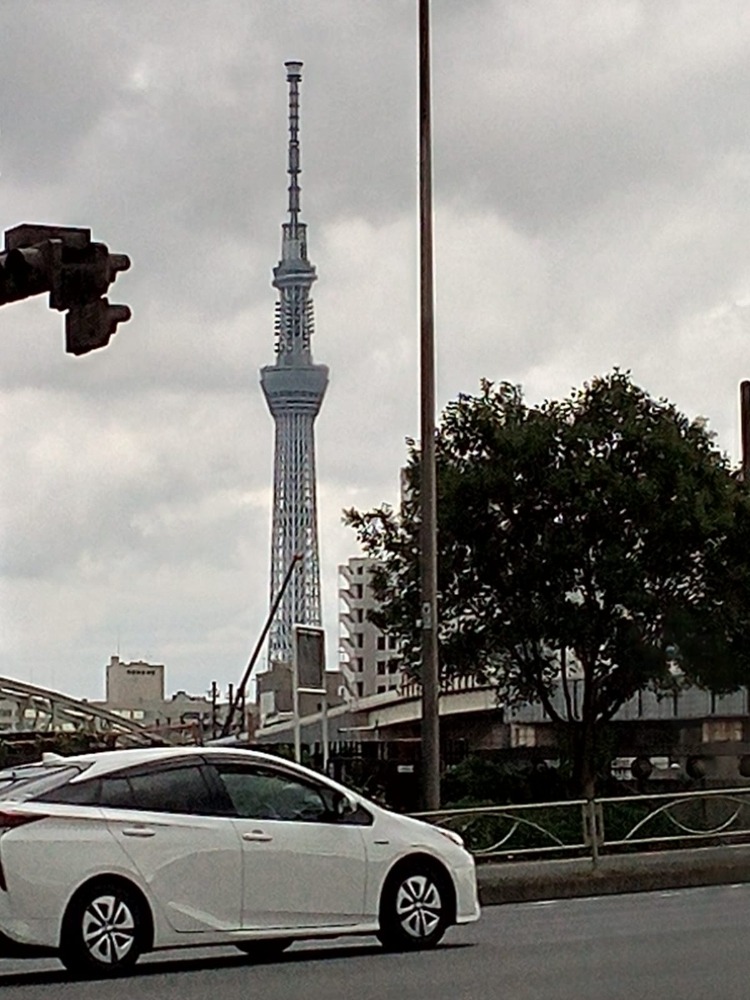
Tokyo restaurant
One of many advertising boards in Tokyo
Sky Tower

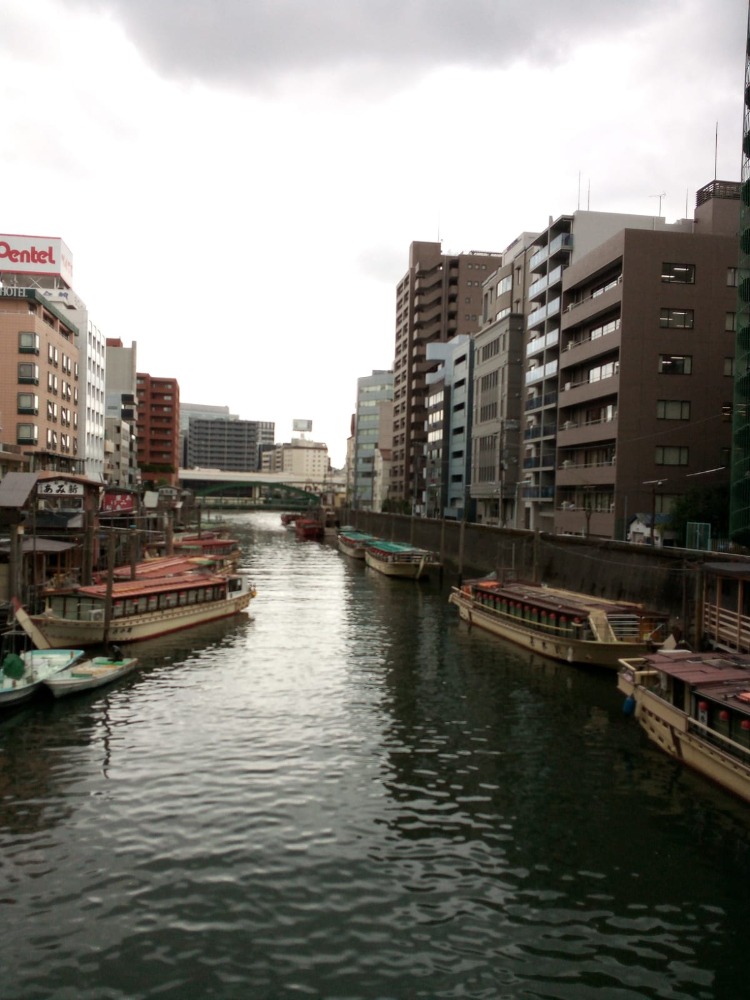

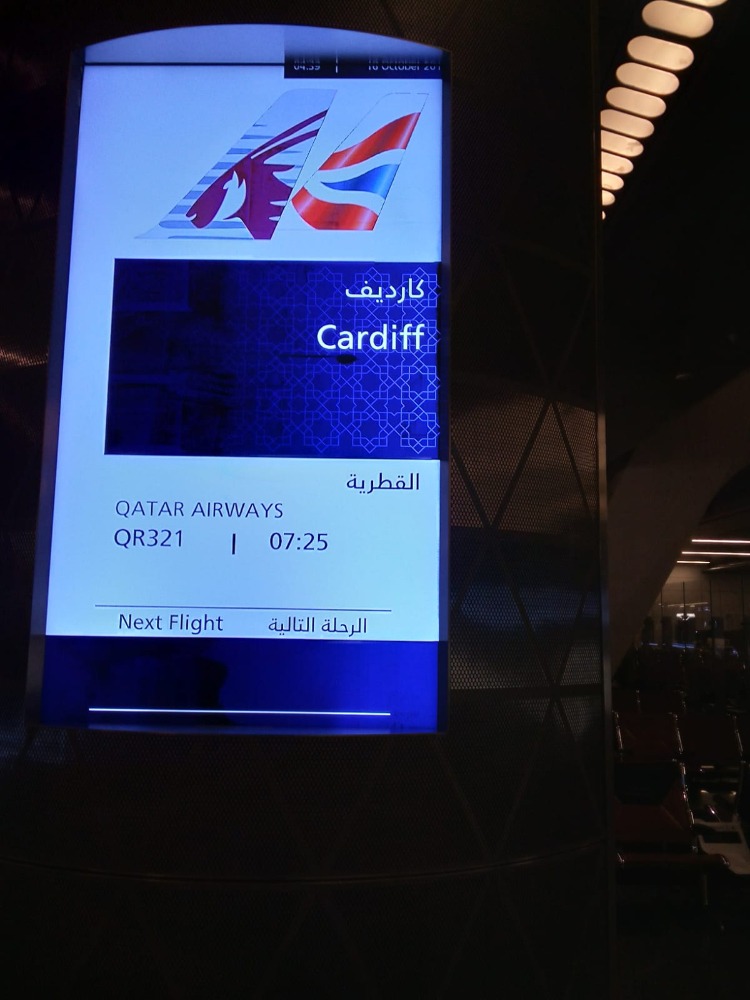
Tomato juice and beer
Downtown Tokyo
No translation needed
Departure board at Doha airport- How to spell Cardiff in Arabic
Tuesday 15th October: More sightseeing then the flight home
Although the last minute rate at the Royal Park Hotel was excellent it didn’t include breakfast. Enjoyed a lie-in whilst reviewing tour guides and devising a plan for the day. Made an in-room coffee before heading out into the grey but dry Tokyo day with a couple of destinations in mind. The guides supplied by Inside Japan were excellent and included suggestions of places to visit at each of the destinations. The morning aim was a walk and metro journey to the Tokyo Sky Tower in one of the more established districts of Tokyo. The traffic on the road and pavement was busy but not manic and consequently I walked all the way to the Tokyo Sky Tower rather than using the metro system.
An aspect of the last 10 days which was difficult to comprehend was the independent decision making. Most previous holidays have either been with my partner/wife or group holidays such as cycling, golf or skiing. However, with this adventure, I would make a plan the previous evening or maybe whilst lying in bed and if the following morning didn’t feel like following through that plan it didn’t matter as there was nobody else involved. The total independence with no responsibility to or for others felt alien.
Tokyo was originally a port town, but as the capital of Japan, really developed in the 1980s and 90s in parallel with the tech boom which catapulted Japan forward. There are many remnants of the old Tokyo particularly along the river system in the east of Tokyo. These old remnants are being replaced at varying speeds with tall and ultra-modern office blocks. This contrast was evident on the hour walk to Tokyo Sky Tower.
I needed to get back to the hotel for check-out at 12:30- no extension was allowed with the rate that I paid. Took a different route back along one of the main rivers in Tokyo. The water level was particularly high following the torrential downpour of Hagibis two days ago. I was hungry so had a late breakfast with a lovely cup of tea at a small but busy café.
Back to the hotel, packed the holdall for storage by the bell boy and checked out. Decided to treat myself to a tea in the hotel coffee shop and catch up with emails, blogs etc. It is the only time in my life I have spent £13 on a cup of tea. The only saving grace was the price included endless refills. I stayed at the coffee shop for 90 minutes enjoying the atmosphere and watching the locals enjoying their very traditional British afternoon tea with little cakes, scones and sandwiches.
The afternoon excursion was a metro journey to Tokyo’s equivalent of Harrods, recommended by the Inside Japan itinerary. The store was to be found in the centre of Tokyo’s business district. The ultra-modern high rise office buildings were breath taking as was the more traditional architecture of “Harrods”. I walked through the district in awe. So much so that instead of taking the Metro back to the hotel, I walked around the business district and using my Tokyo visitor map, devised a detour back to the hotel.
Time to retrieve my holdall, change into travel clothes and ask the bell-boy the easiest way to get to Tokyo central station to take the Narita express train to Tokyo’s second and smaller airport at Narita.
Included with the Inside Japan itinerary were tickets for all aspects of the adventure. These included hotel vouchers, the 10 day green railcard, bus trips, ferry crossing and the IC card for the Tokyo subway system. The package also included a ticket for this last leg of the journey, the Narita express train.
One of the hotel’s information staff overheard my conversation with the bell-boy and suggested that rather than taking a taxi to Tokyo main station in the middle of rush hour and then the stress of finding the Narita platform amongst the hordes of commuters, I should take the Narita airport transfer bus. The bus terminal was adjacent to the Royal Park Hotel and the journey would be shorter, less stressful and cheaper than the Narita express train. The hotel information guy was Italian and had moved to Japan more than 16 years ago. He said the culture in Japan was so much more to his liking than anywhere in Europe. He walked with my holdall the short distance to the Narita bus terminal where I boarded the efficient and modern coach to Narita airport. The hostess on the coach, stood up, bowed in true Japanese tradition and then requested we put on our seat belts and refrain from using mobile telephones and eating on the 1hour journey.
At the airport, it was announced that the Qatar Airways flight to Doha would leave 20 minutes early. On-board I watched the last episode of Chernobyl before luckily falling asleep.
There was a two-hour stopover in Doha before the very last hop of this amazing adventure on a BA flight to London Heathrow. The BA 787 cabin was such a disappointment following the relative luxury of Qatar Airways; the catering and inflight entertainment likewise were far inferior to that of Qatar airways. Every Qatar flight was full, but the BA aircraft was probably 20% of capacity- something wrong somewhere with BA business strategy.
The 10 day adventure was fantastic and thanks again to nephew Neil for inviting me to compile the daily diaries and to share the experiences of the last 10 days with the readers of Parallel.cymru. I have learnt so much during this journey. The politeness and discipline of Japanese culture; their determination to preserve their island as best they can in a consumer driven climate. Everyone seems focussed on their role in Japanese society- whether it be cleaning, efficient public transport, manufacturing, agriculture or public services. There is discipline, focus and efficiency with a common direction and understanding. I am proud to be Welsh and British, but my eyes have been opened by a wonderful culture elsewhere.
And as for RWC2019, if there is ever an opportunity to attend a global sporting event, then it is strongly recommended. The atmosphere, national pride and just being with people with common interests is simply amazing.






